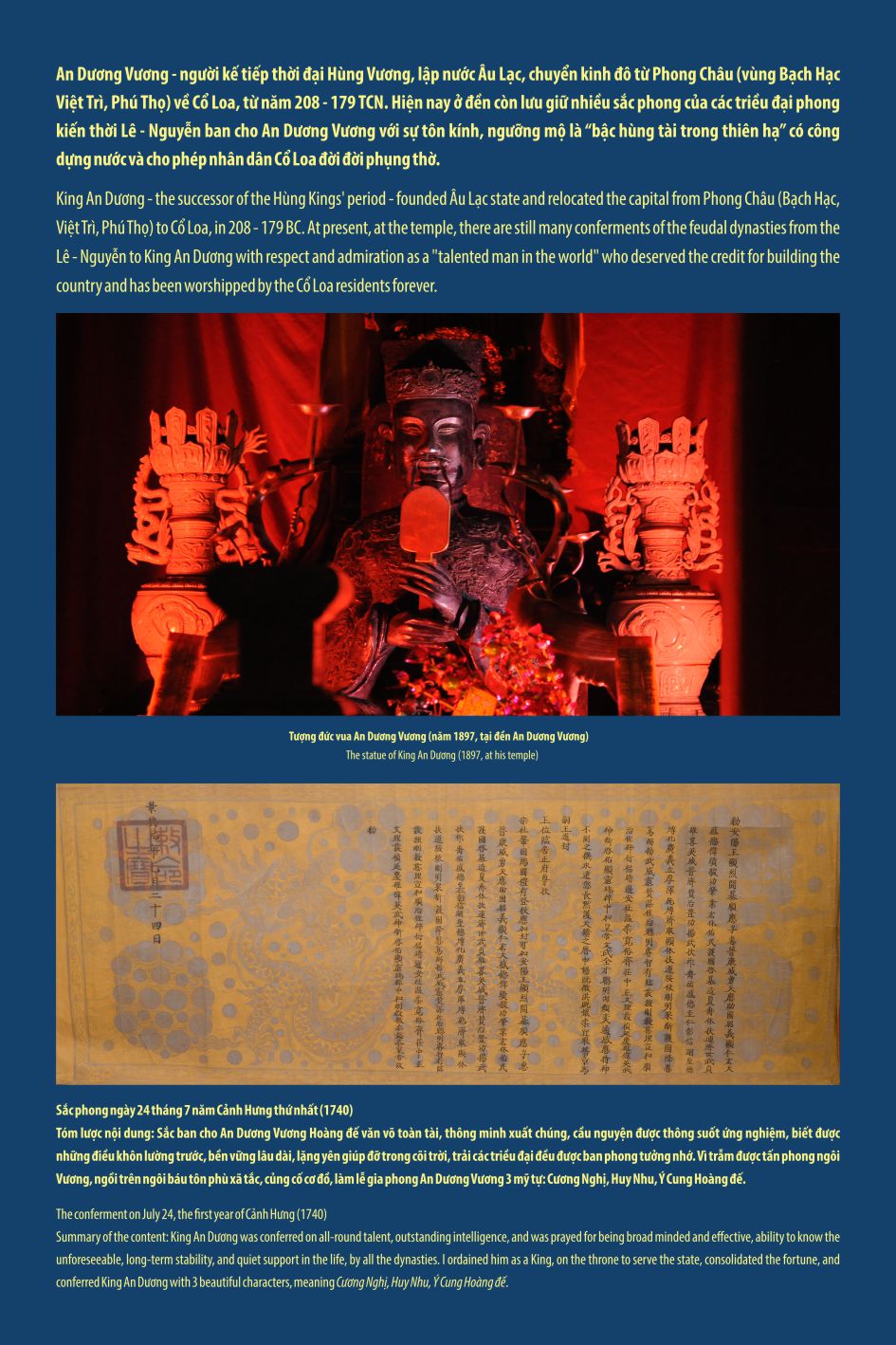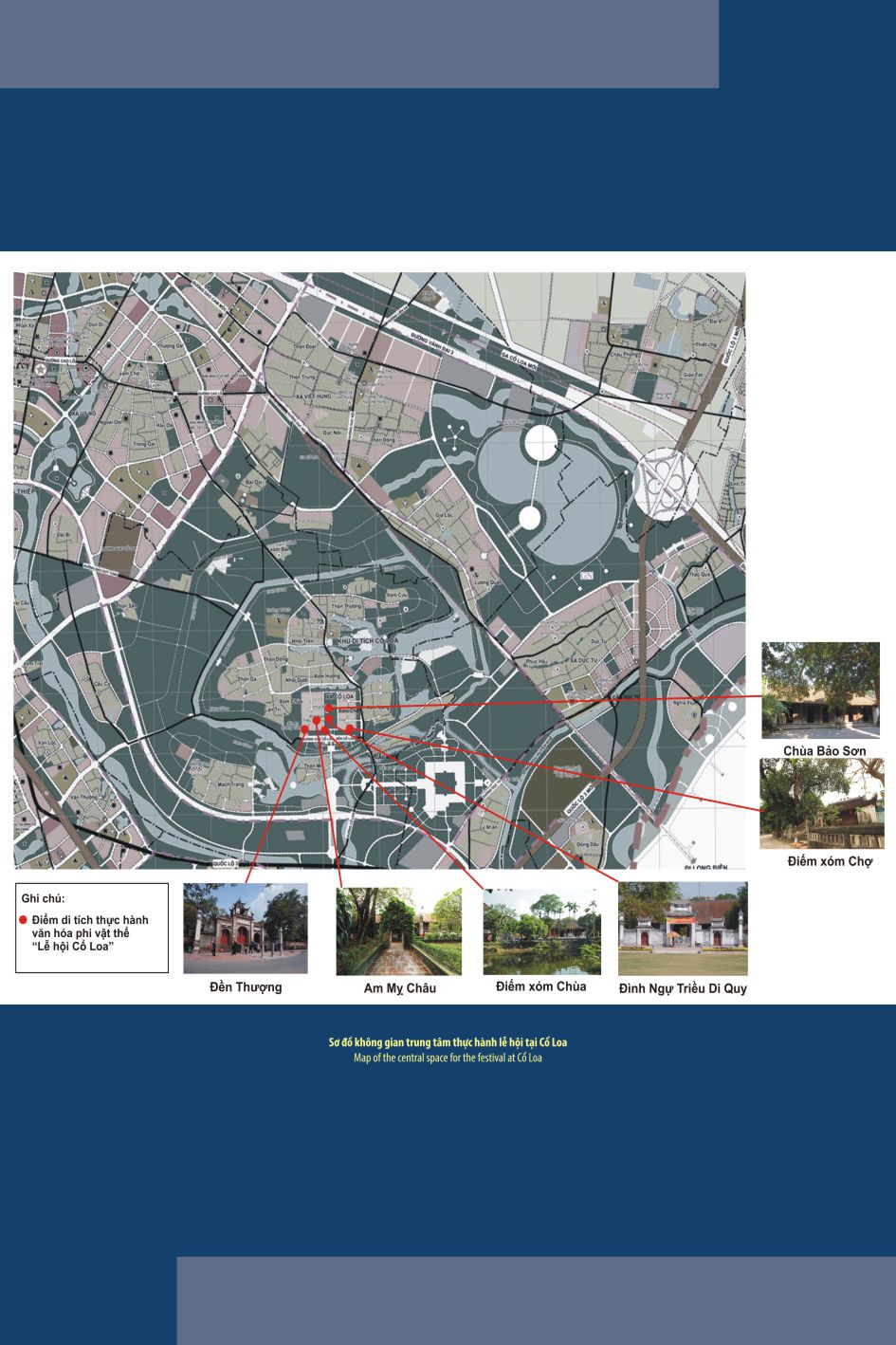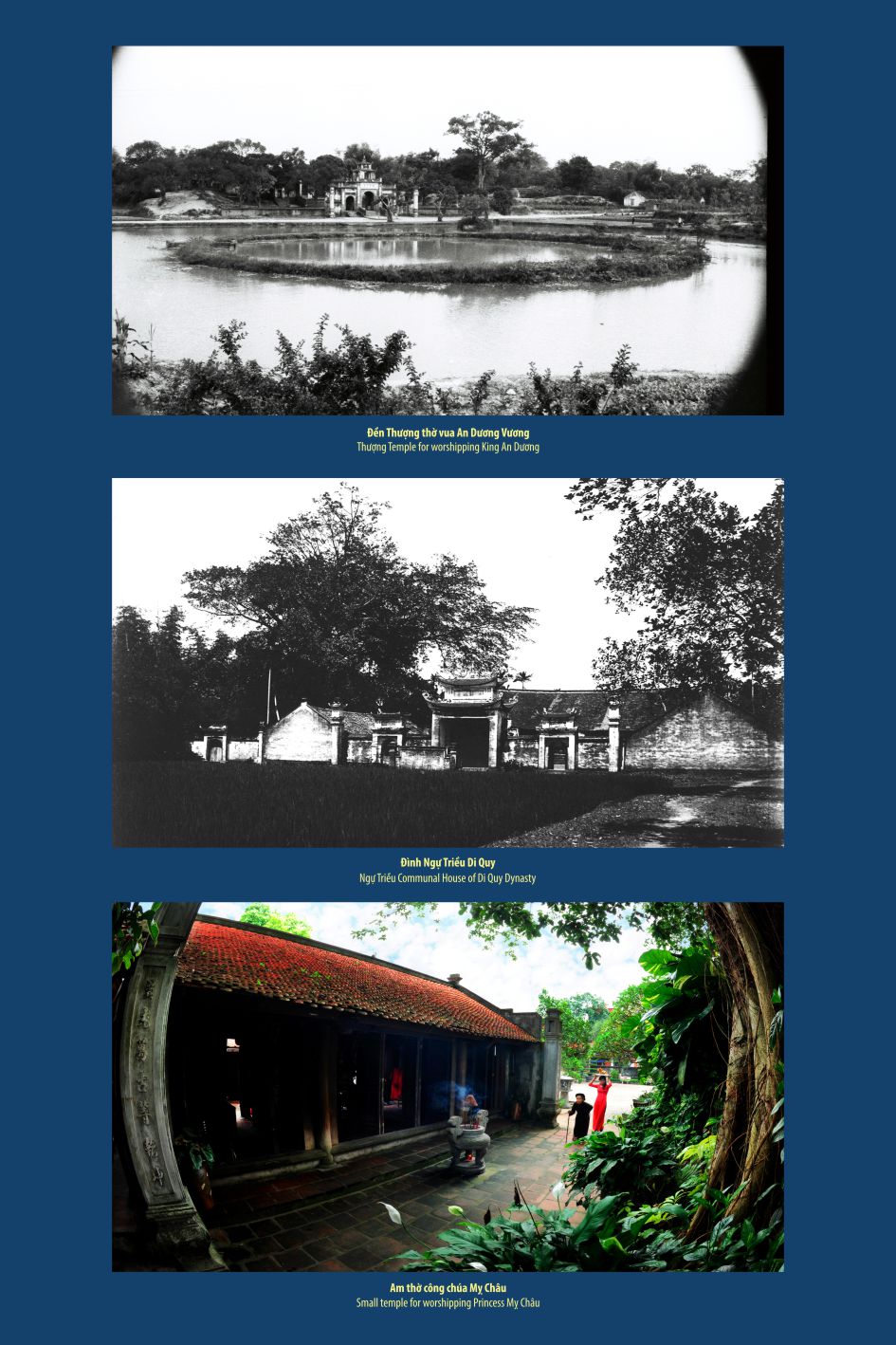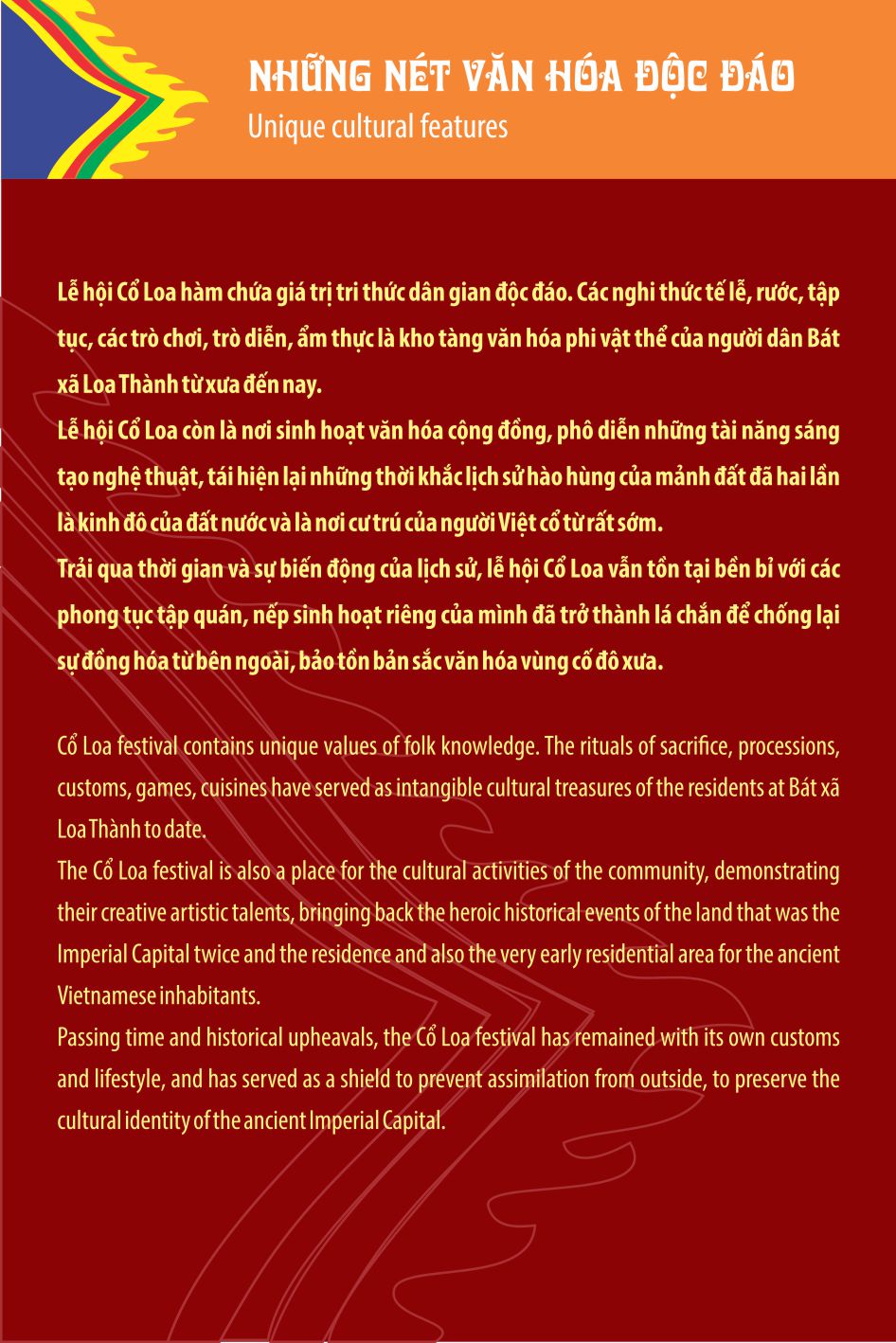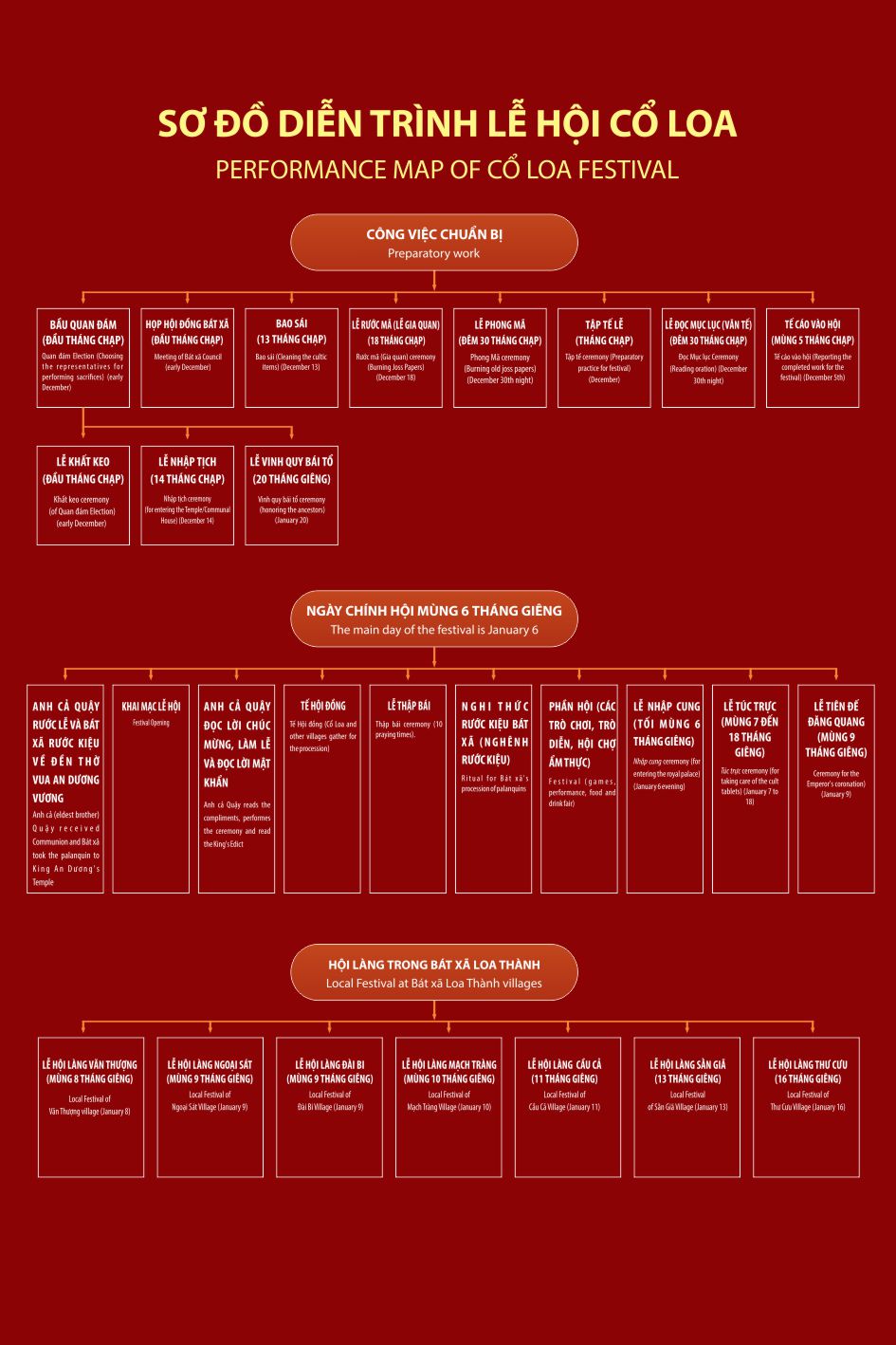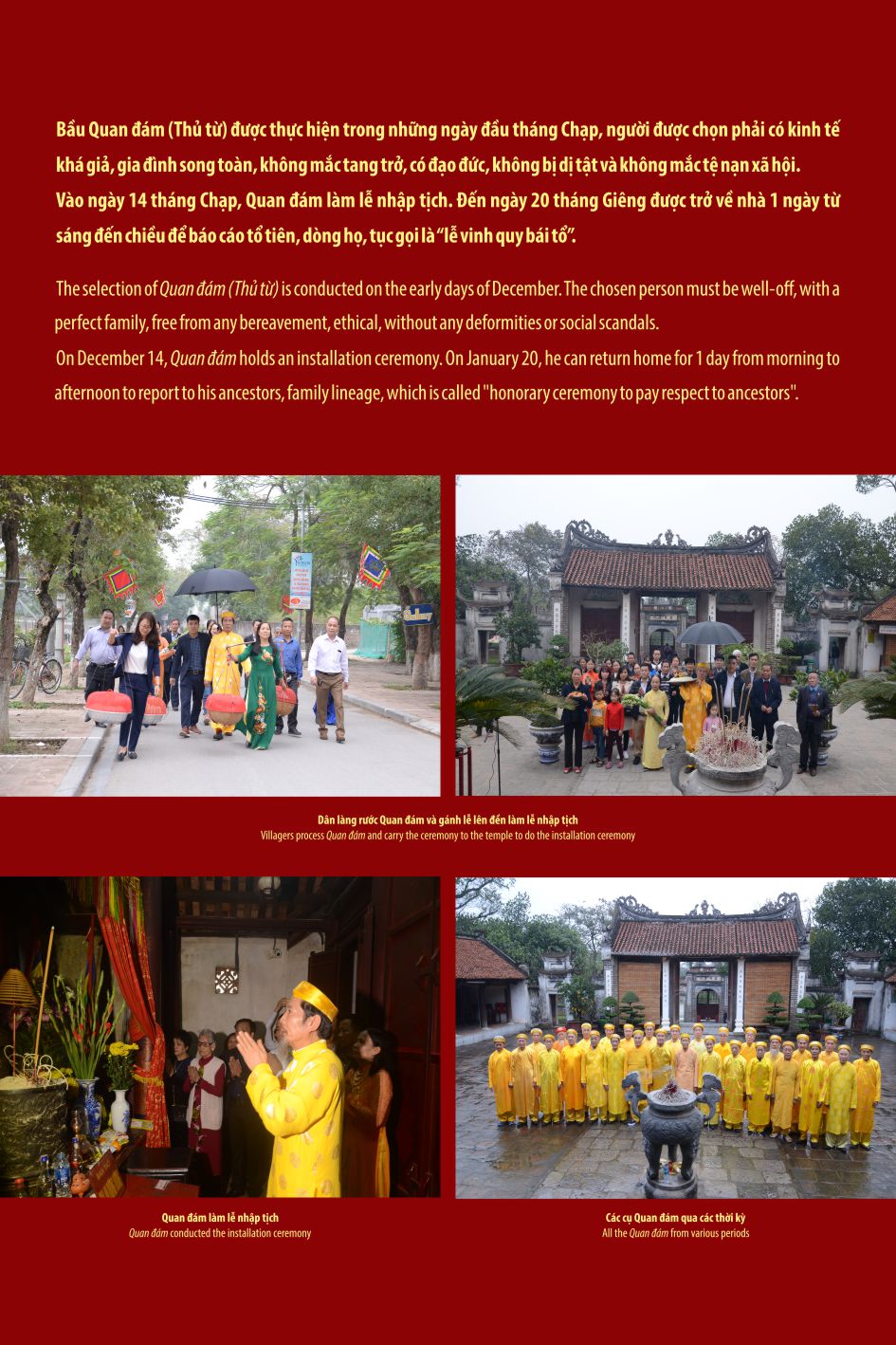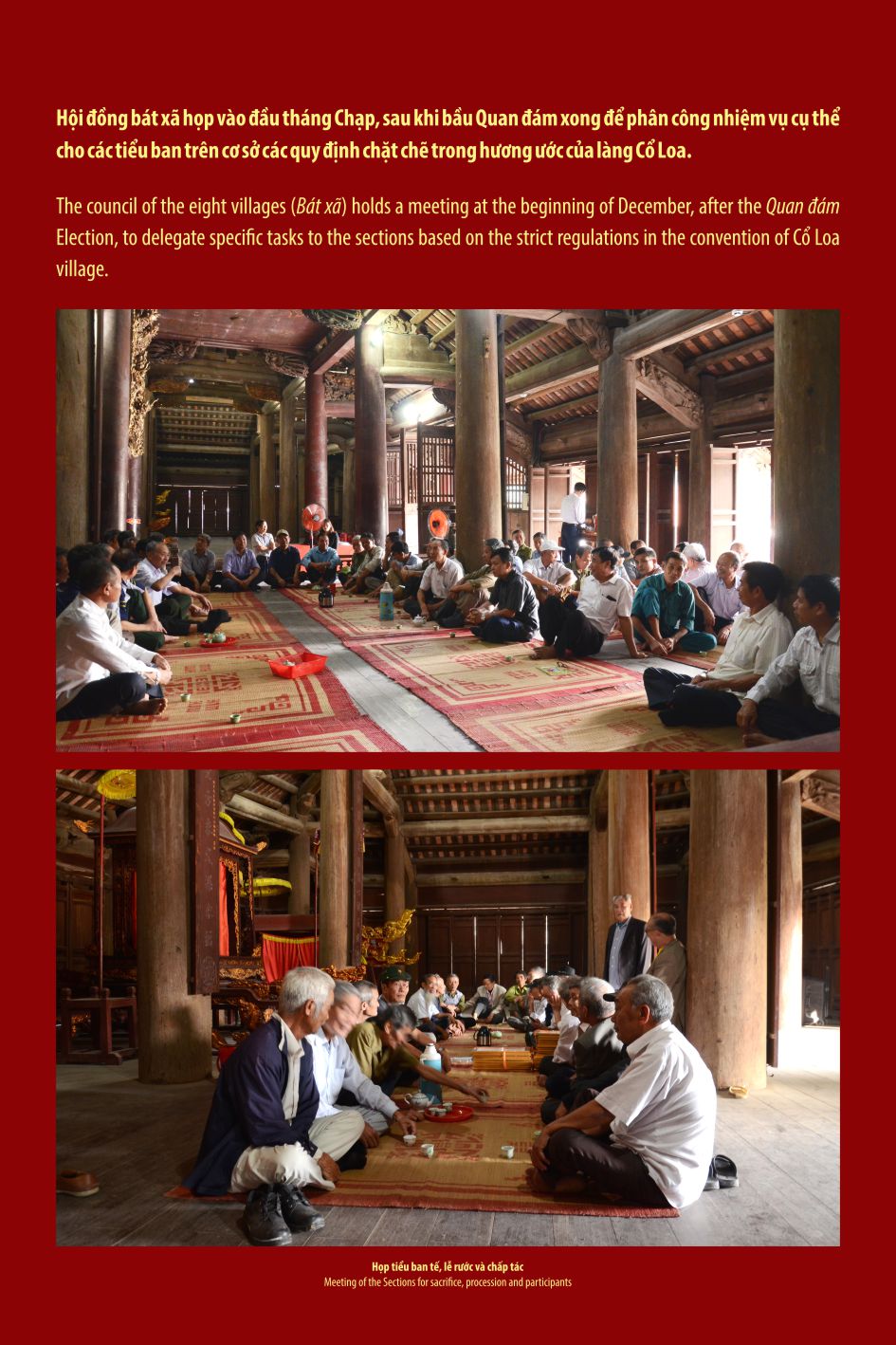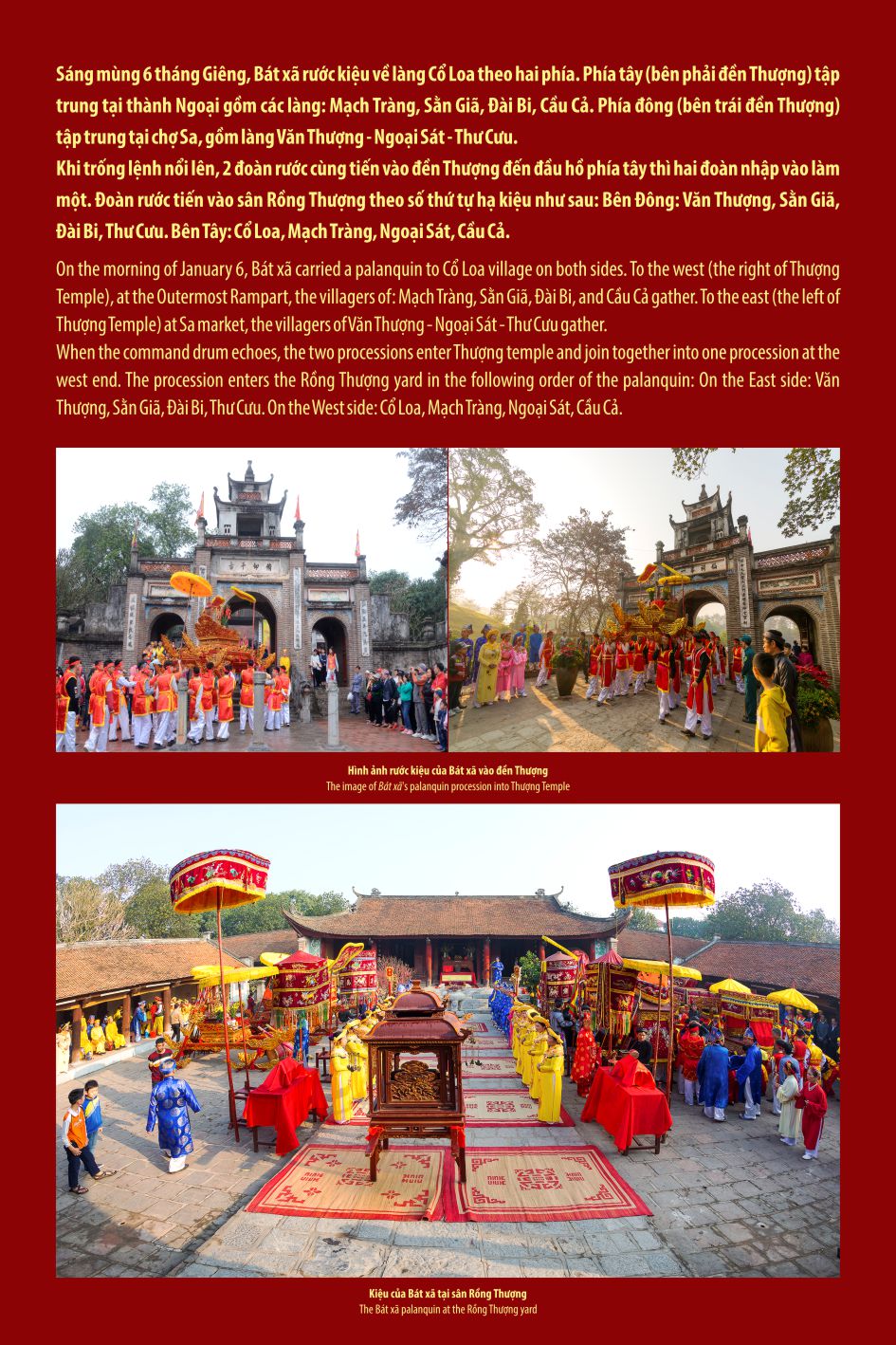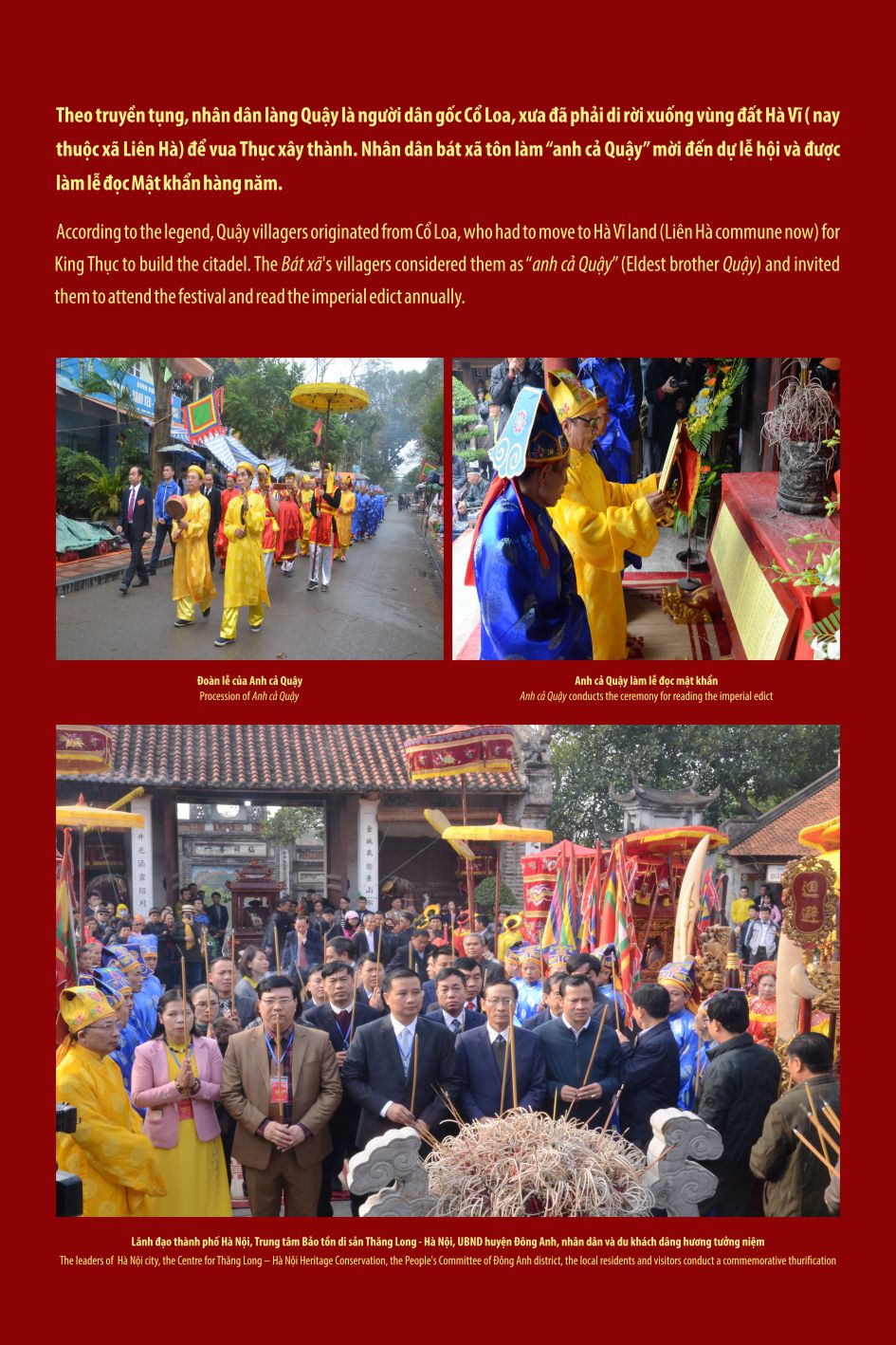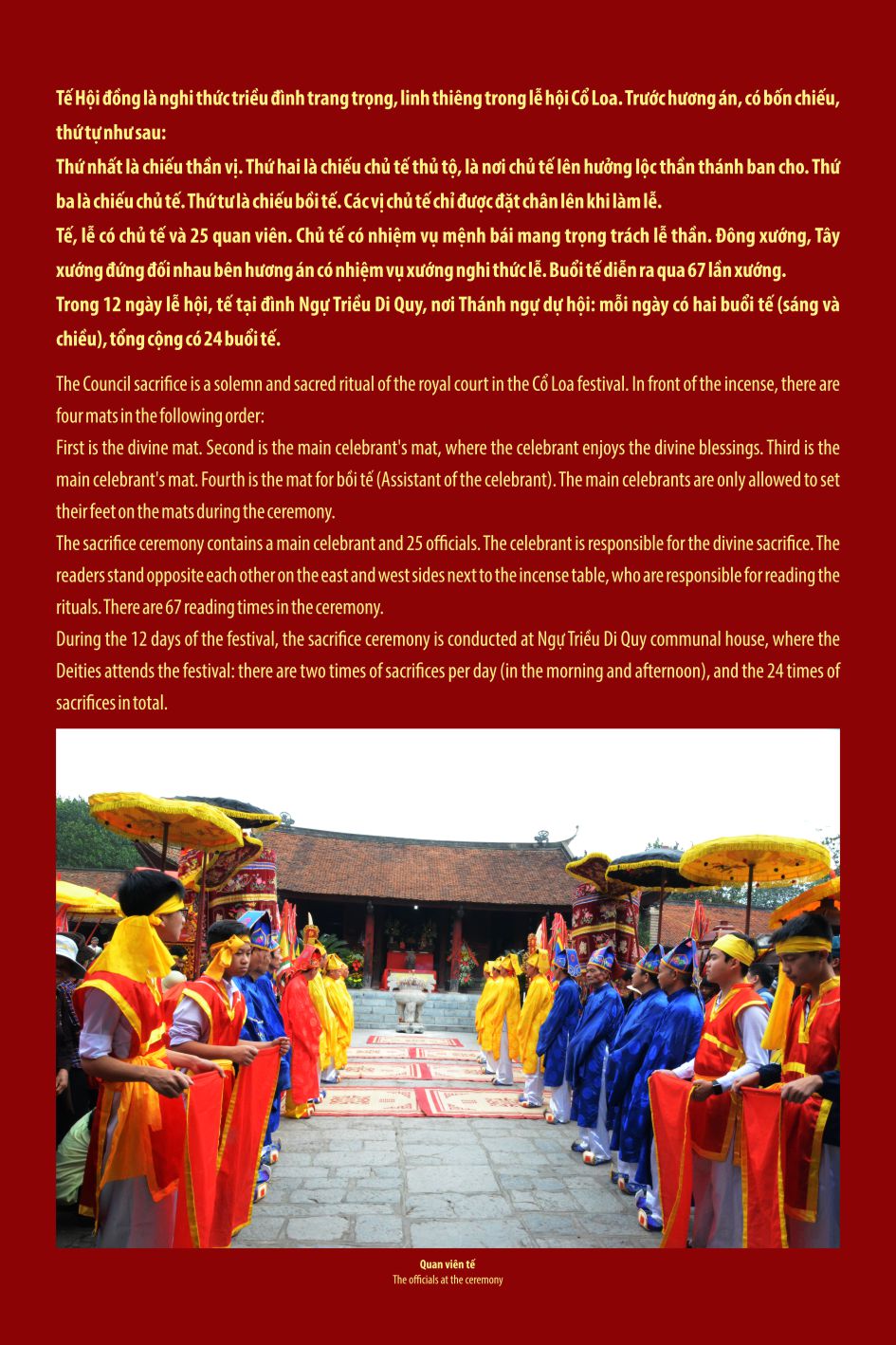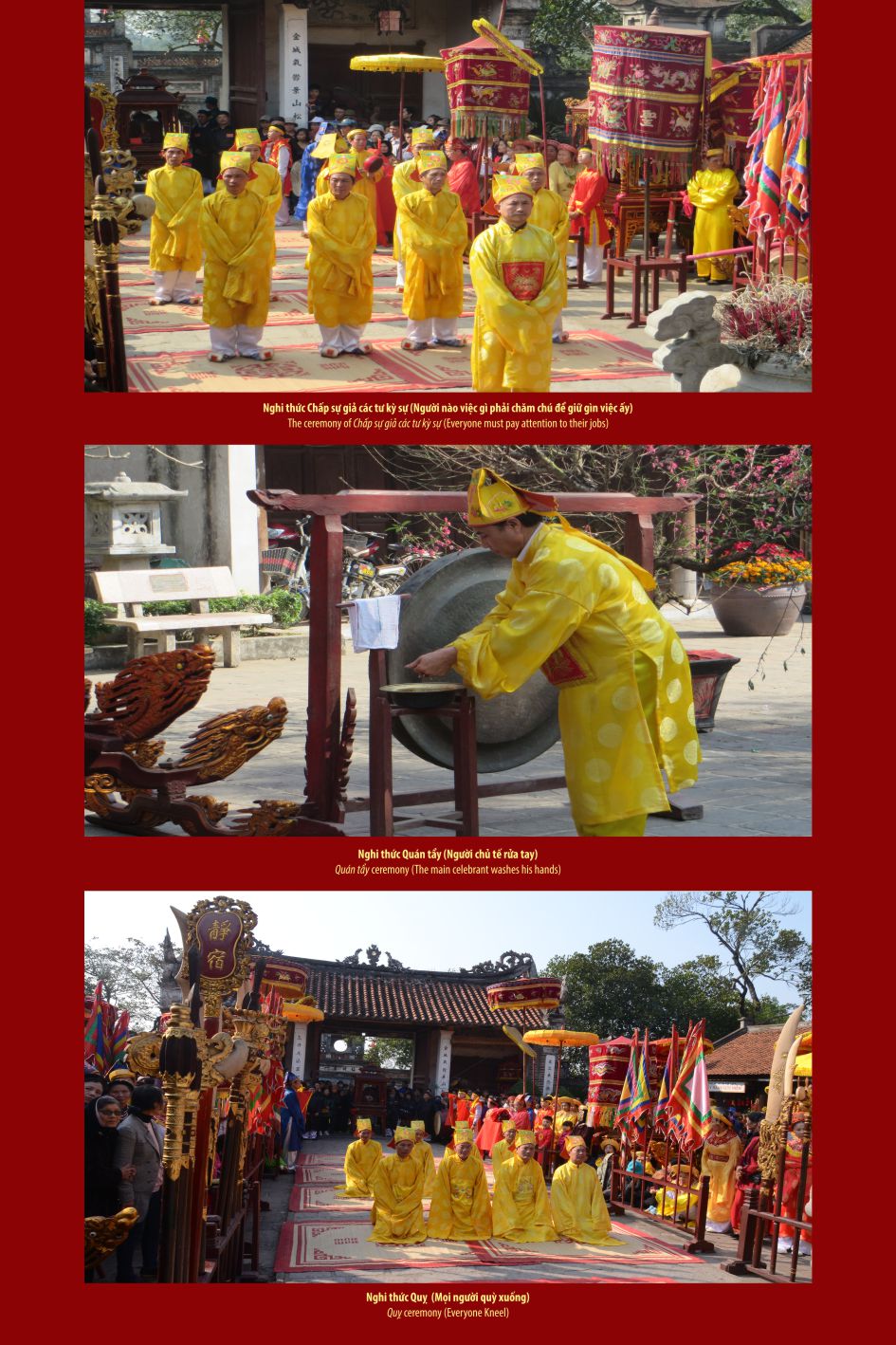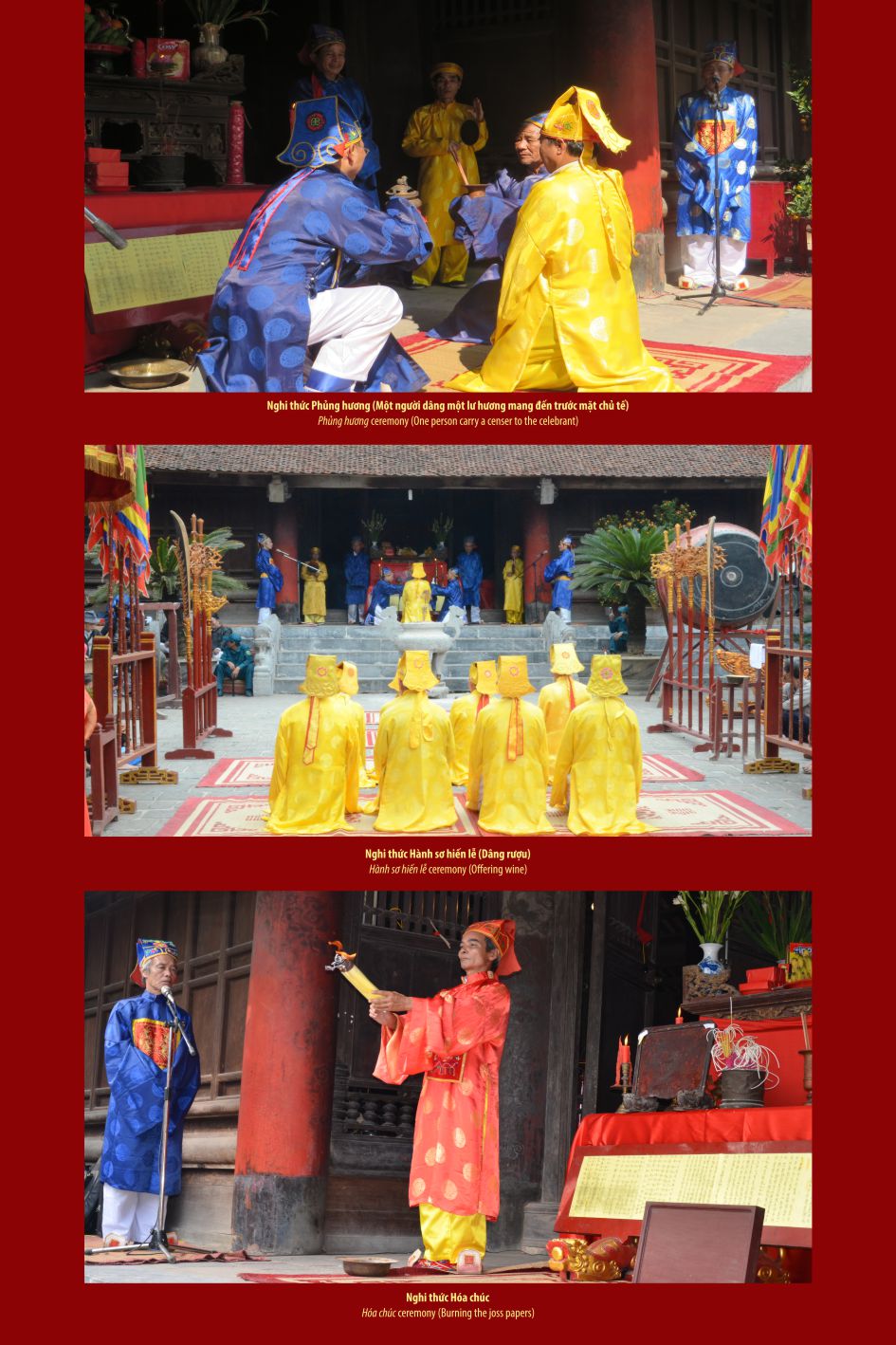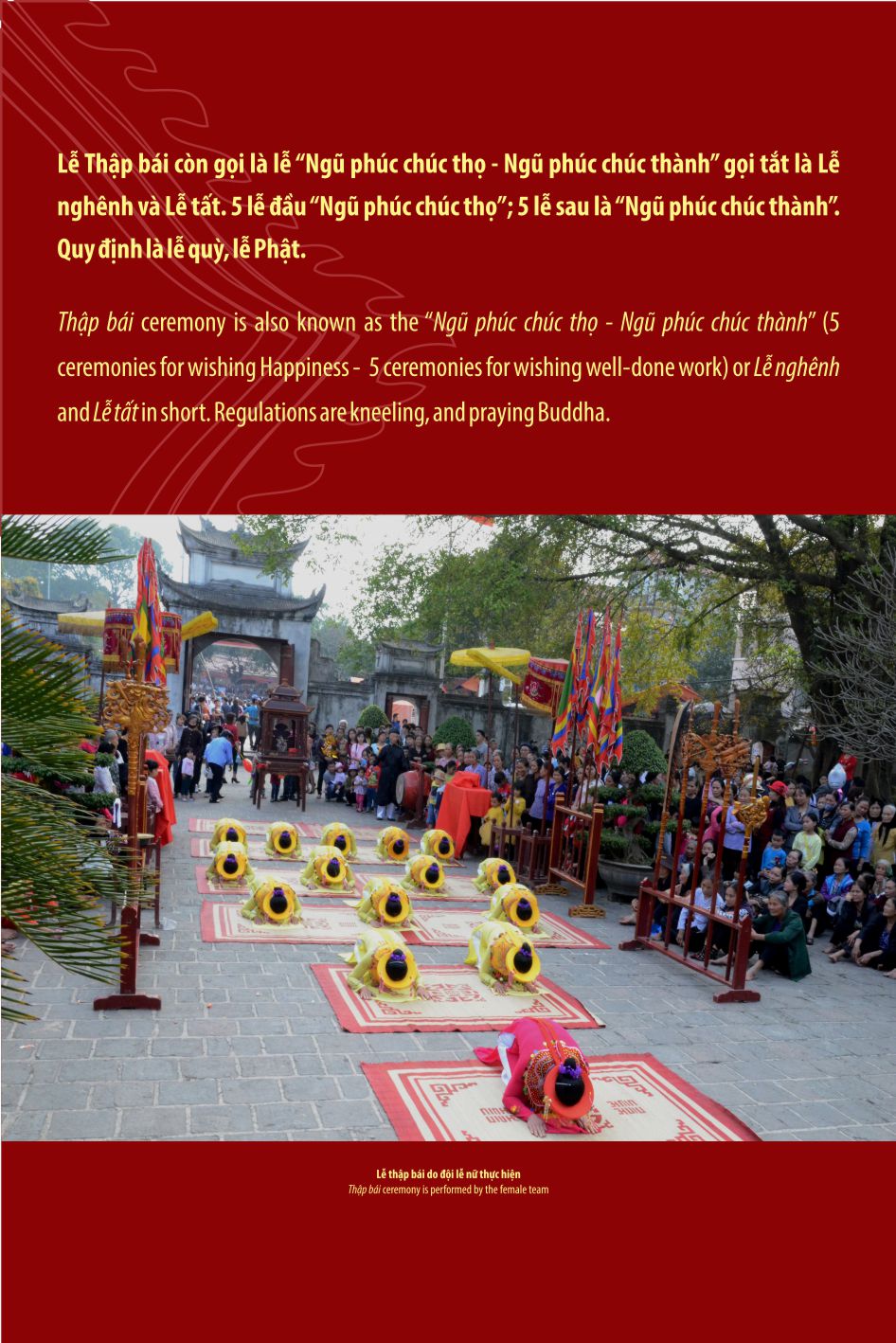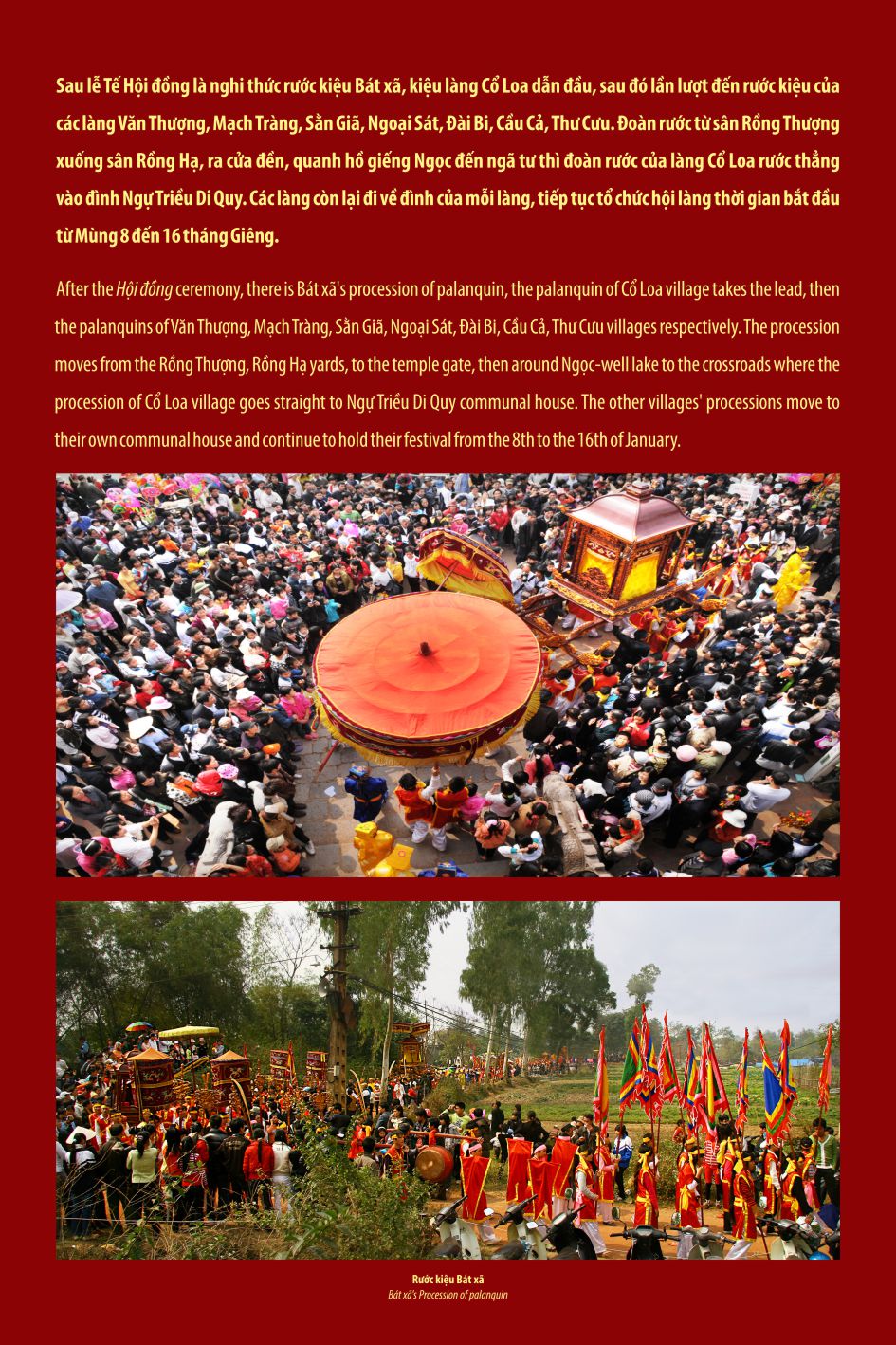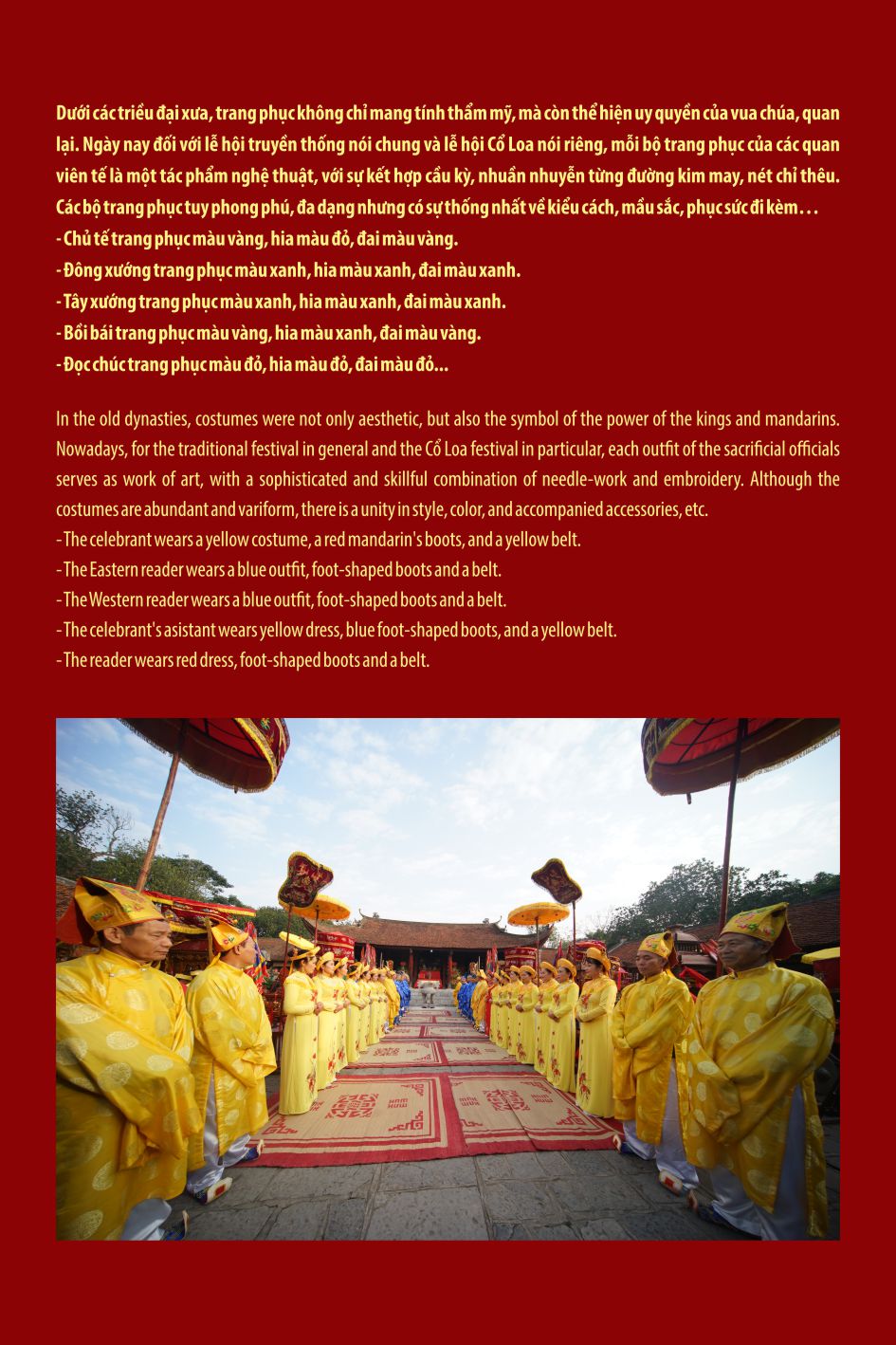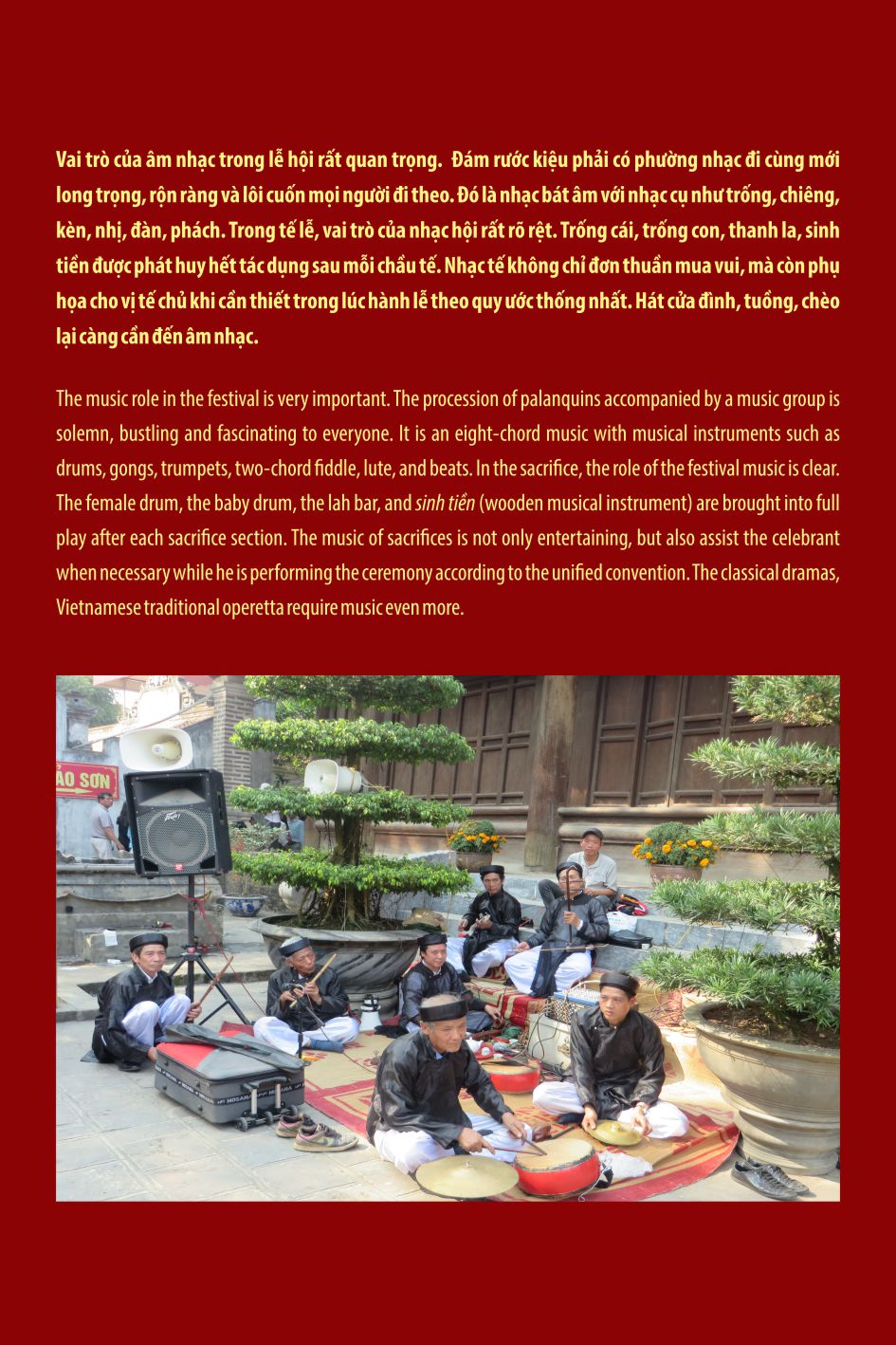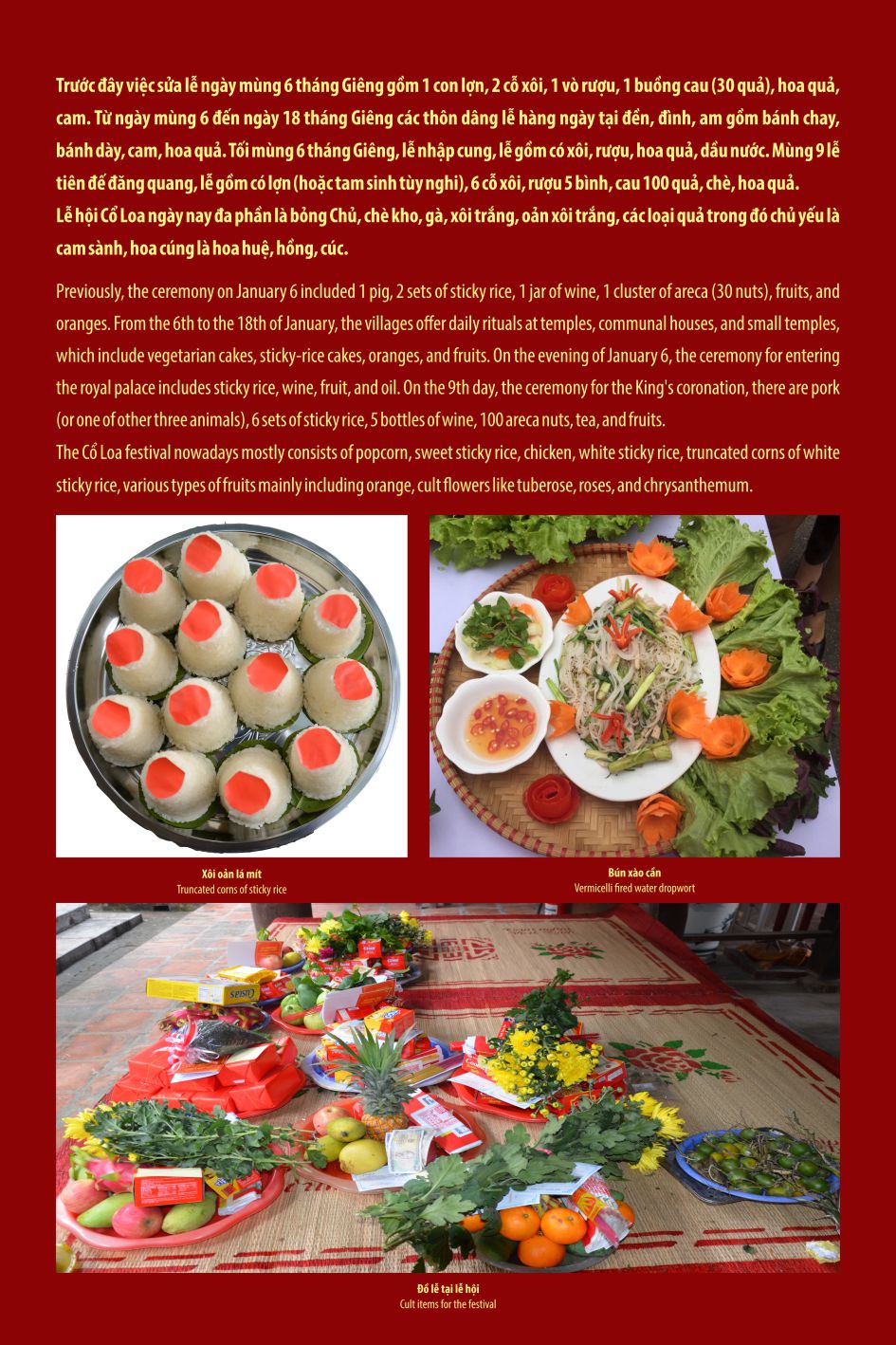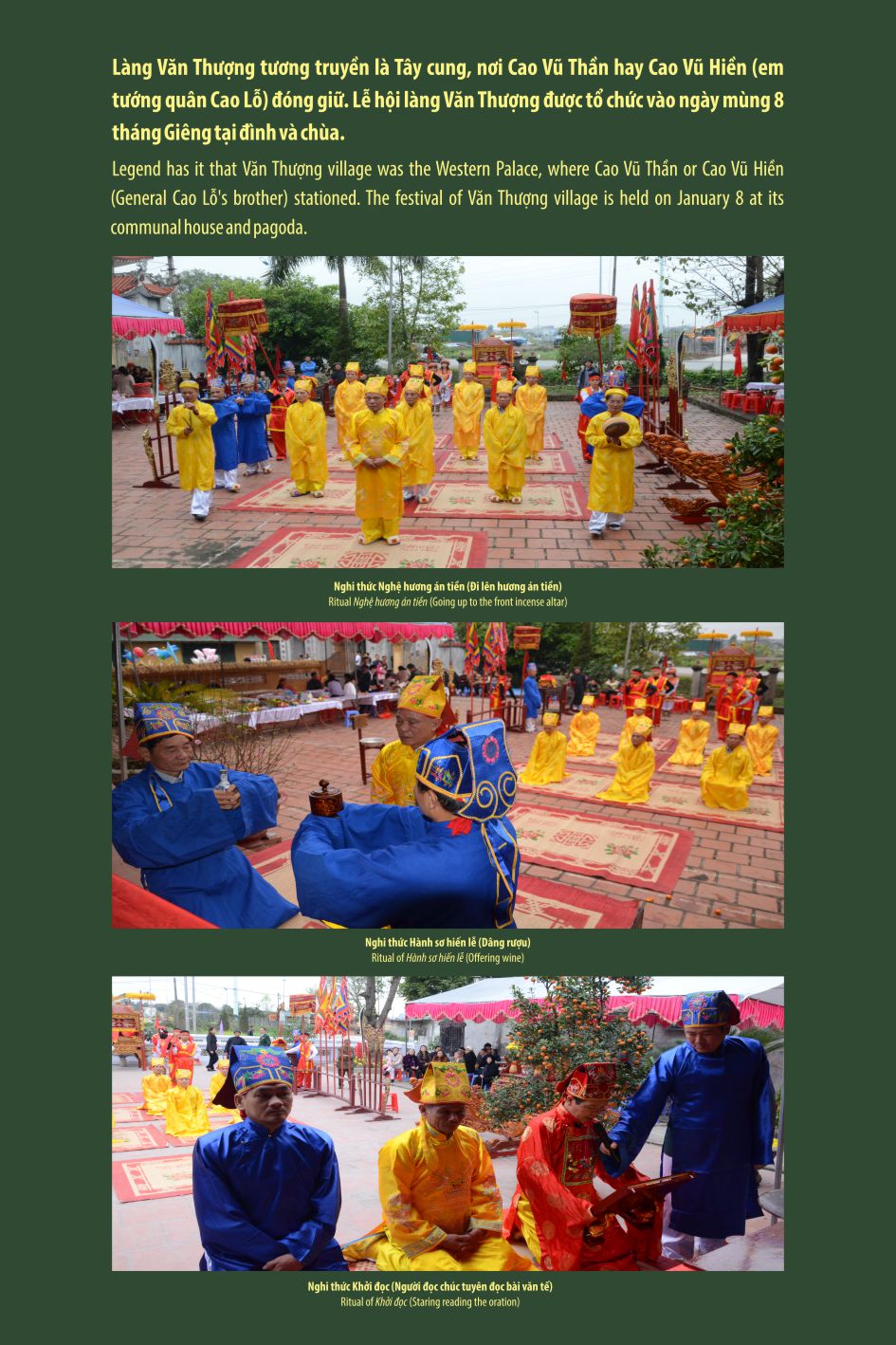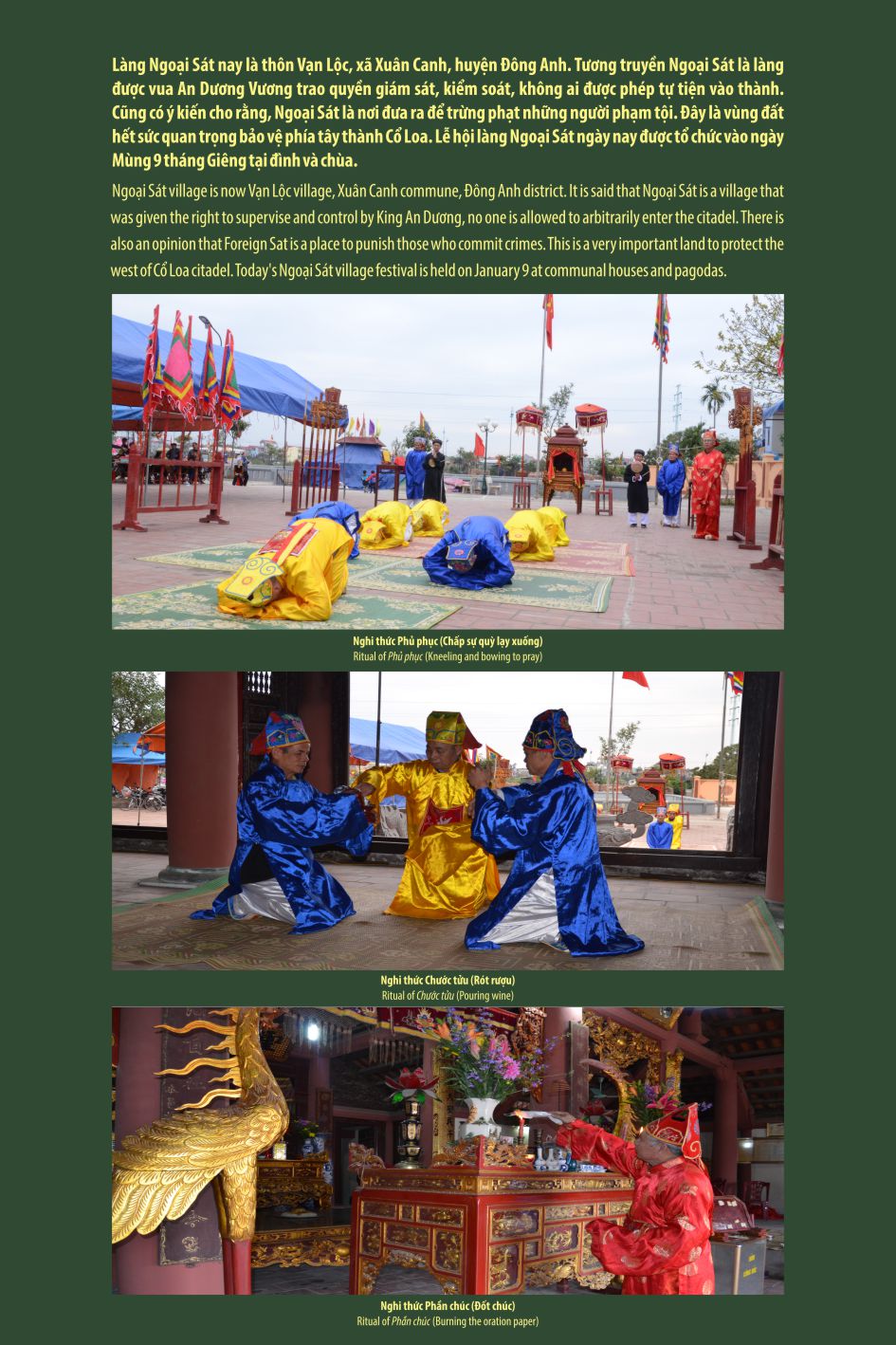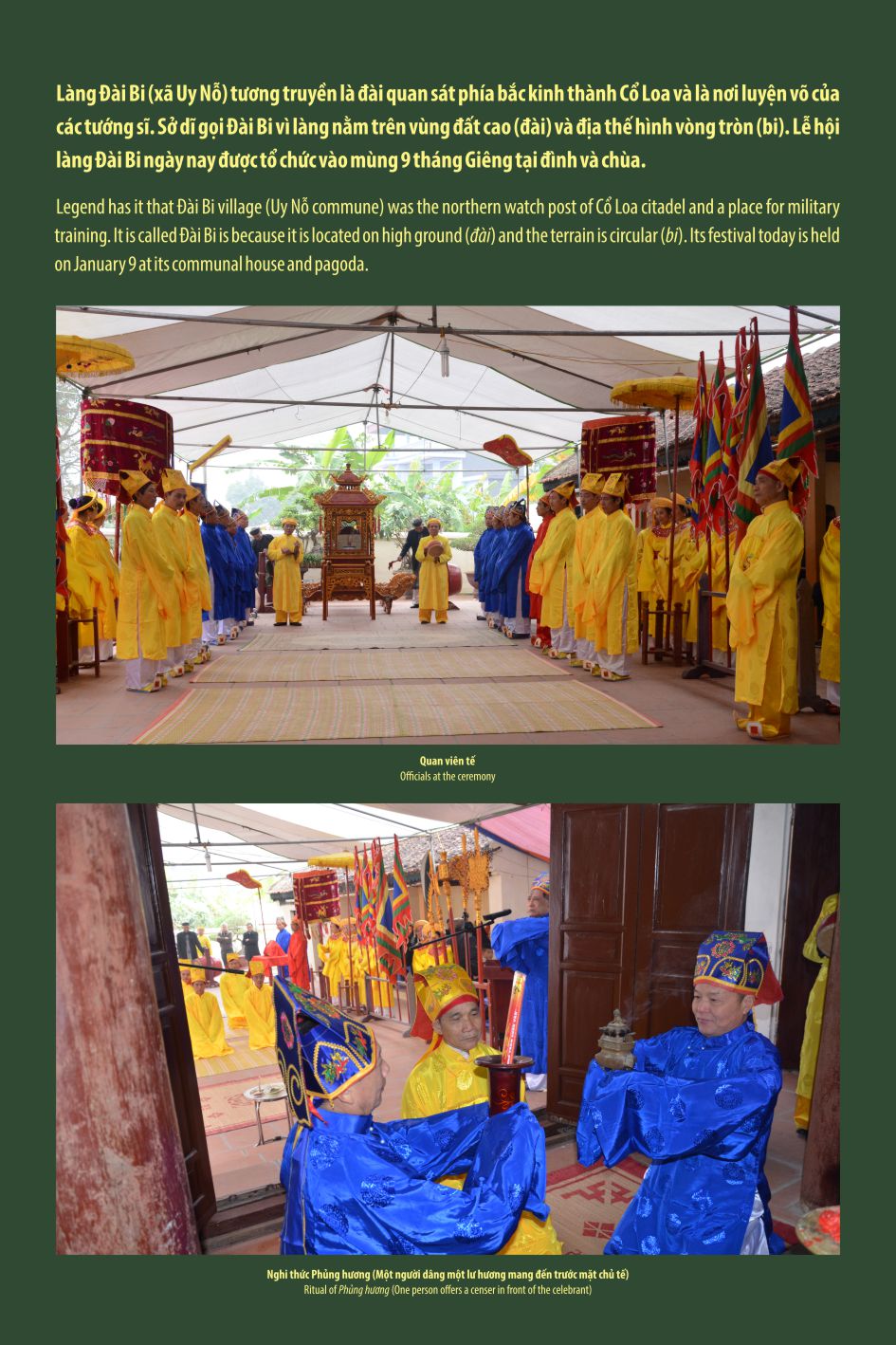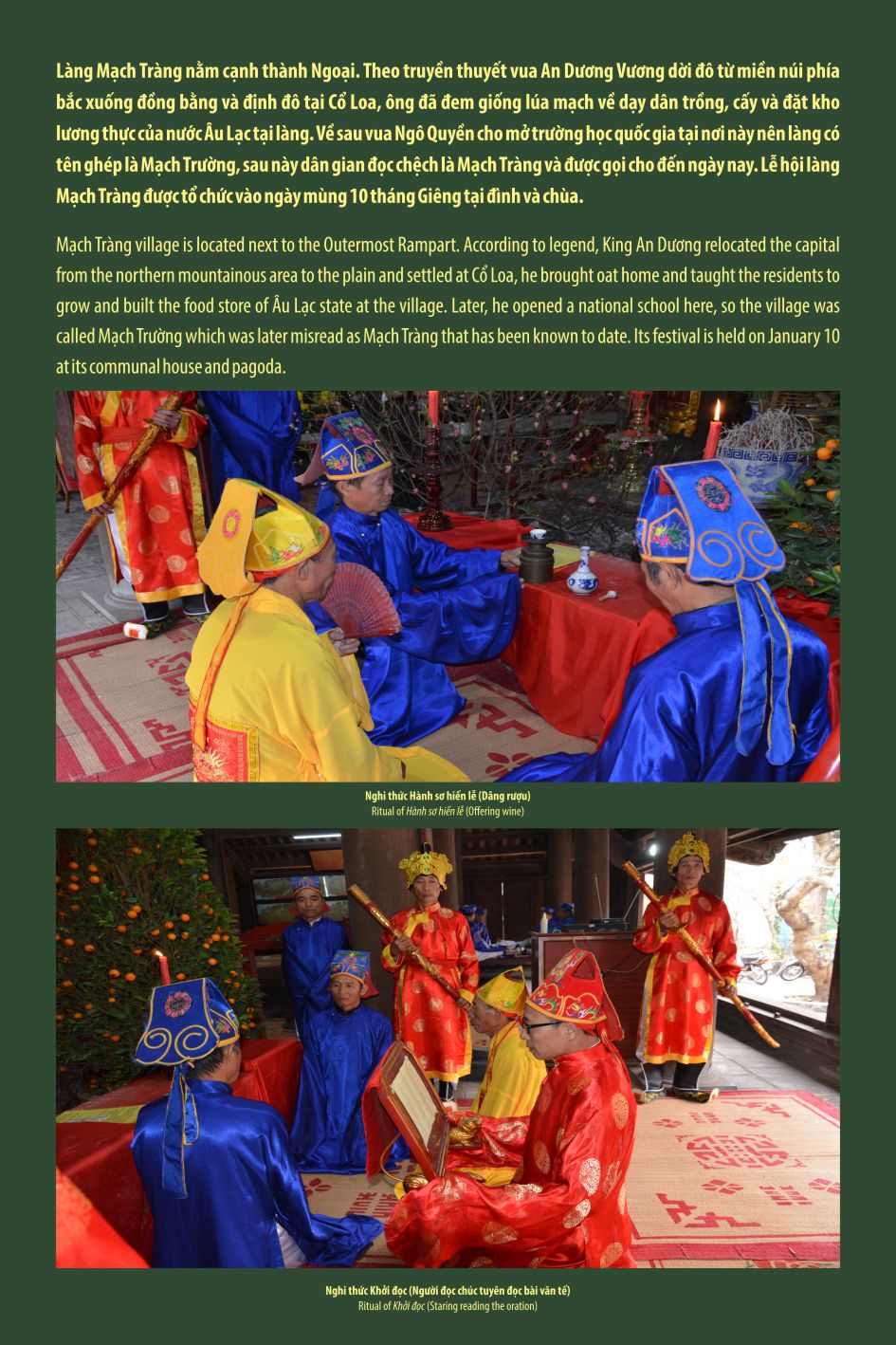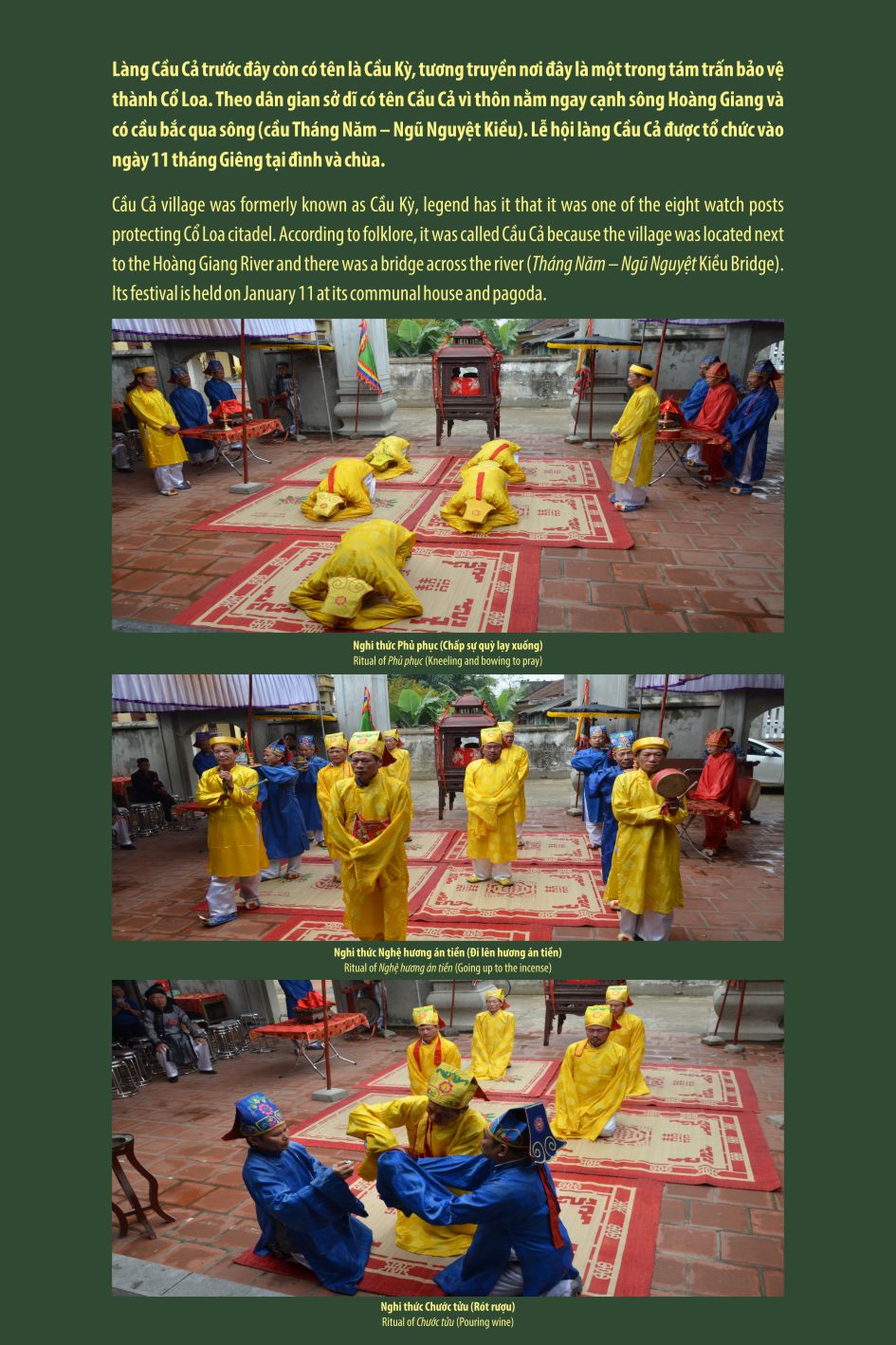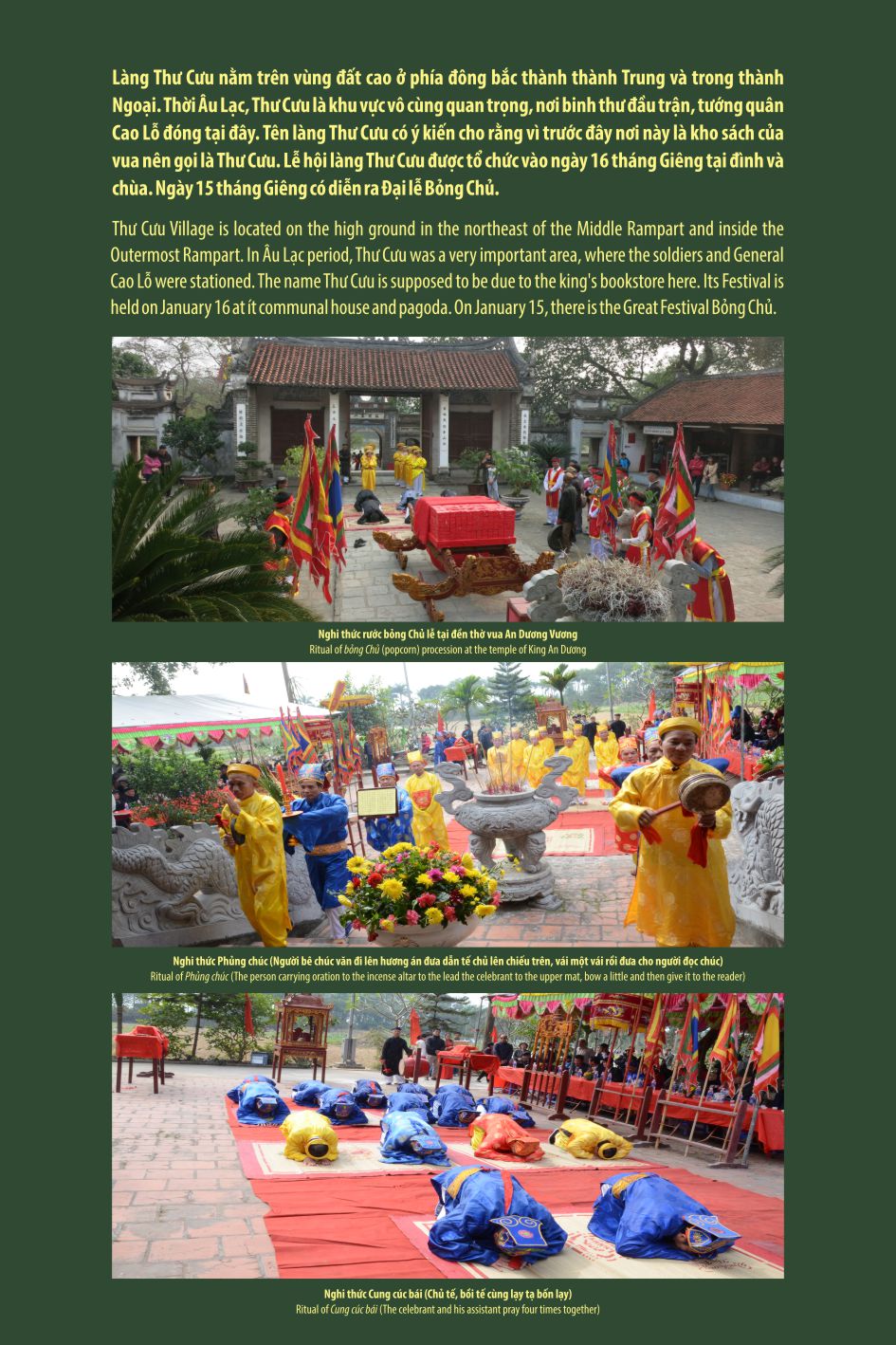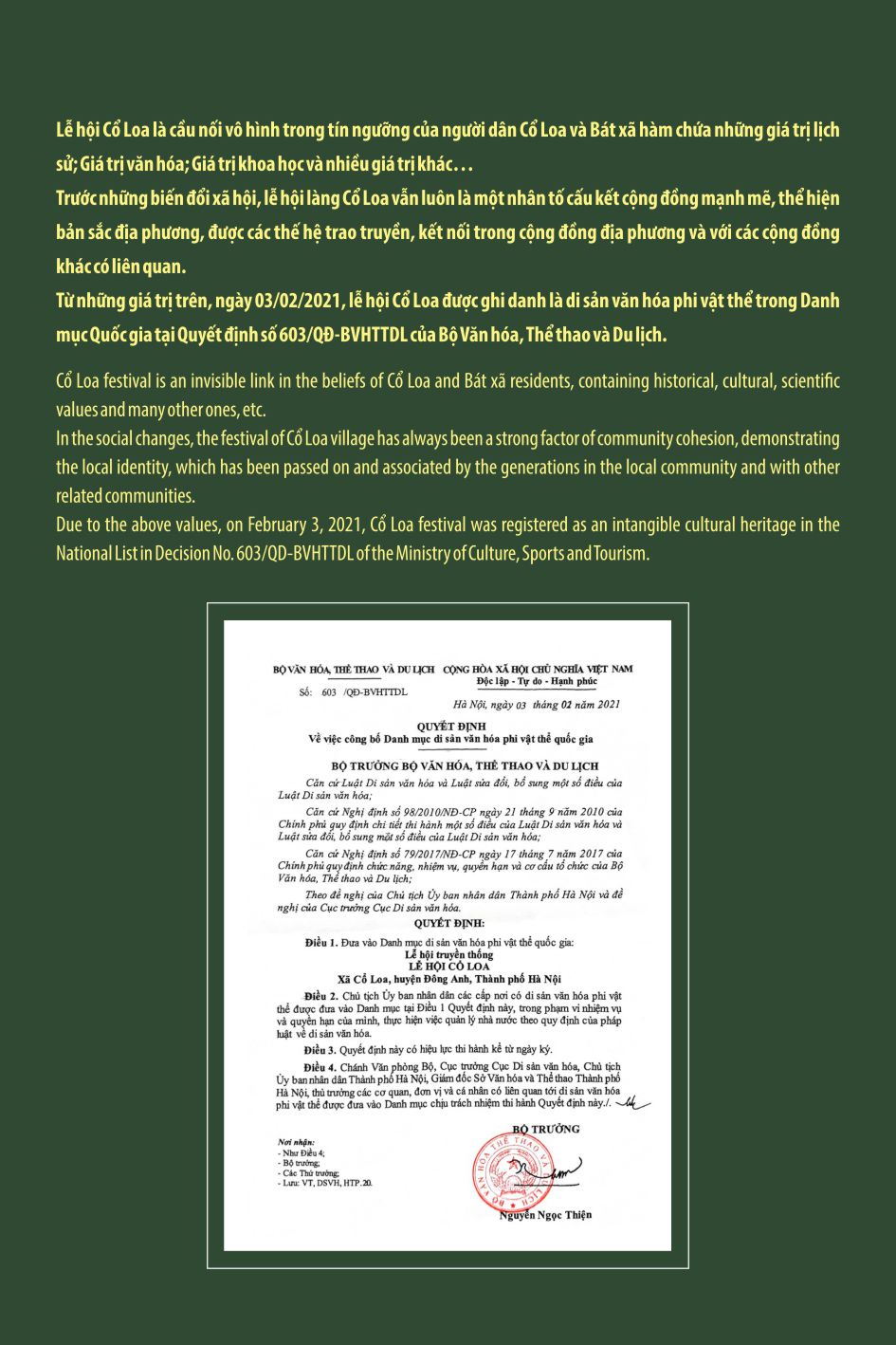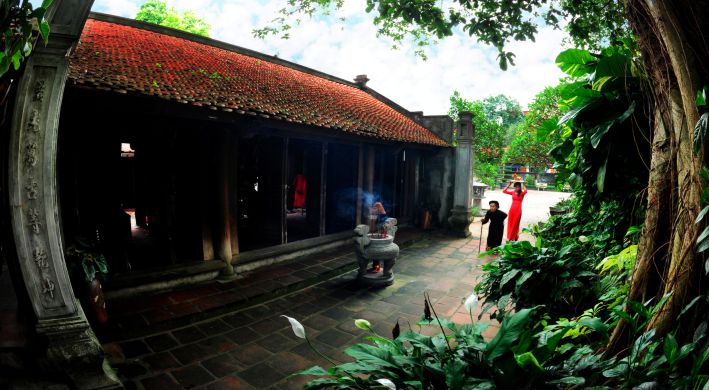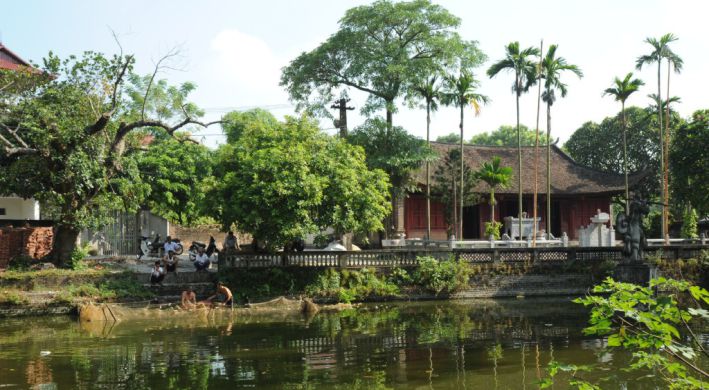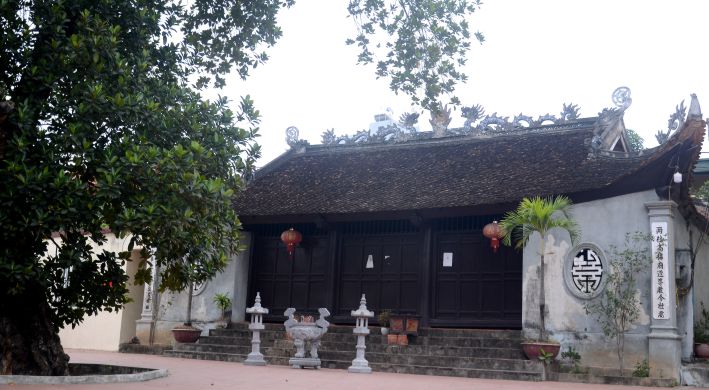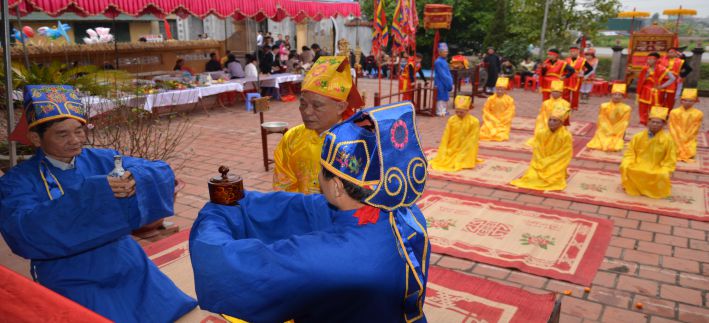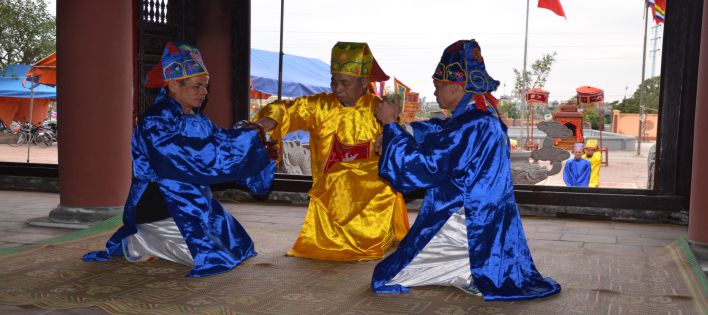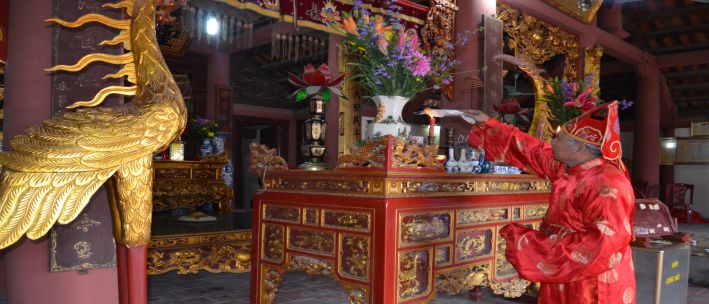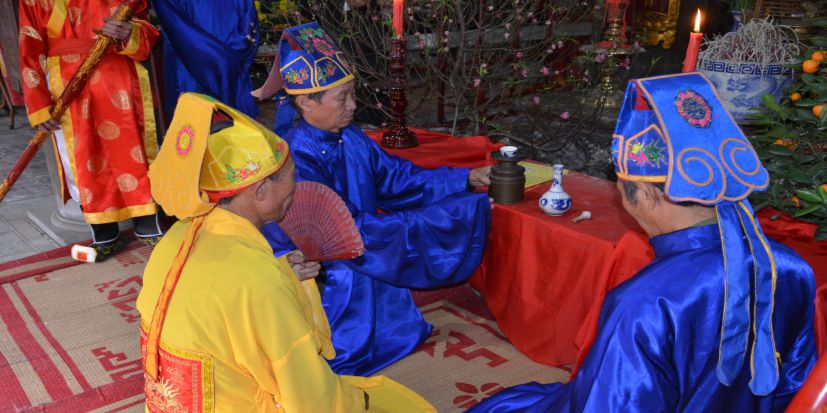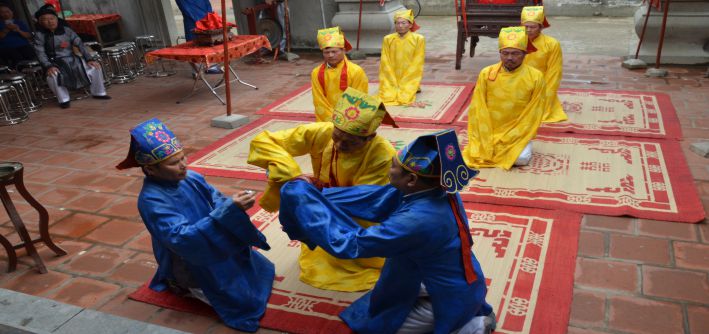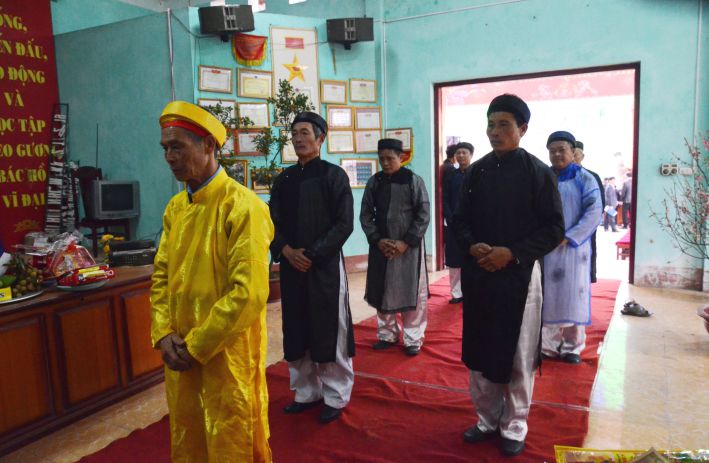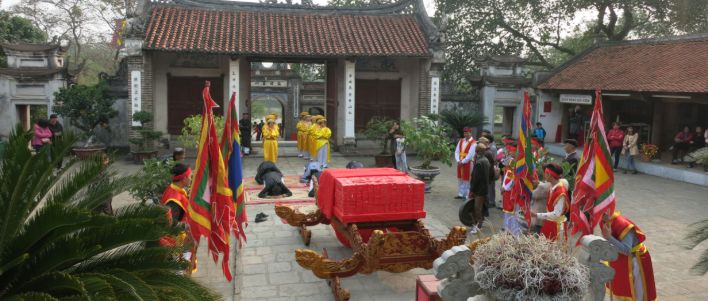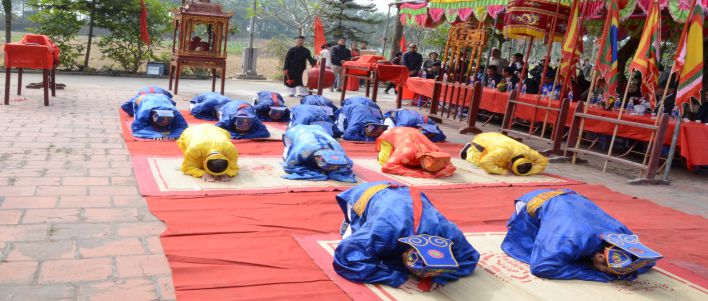
Cổ Loa festival contains unique values of folk knowledge. The rituals of sacrifice, processions, customs, games, cuisines have served as intangible cultural treasures of the residents at Bát xã Loa Thành to date.
The Cổ Loa festival is also a place for the cultural activities of the community, demonstrating their creative artistic talents, bringing back the heroic historical events of the land that was the Imperial Capital twice and the residence and also the very early residential area for the ancient Vietnamese inhabitants.
Passing time and historical upheavals, the Cổ Loa festival has remained with its own customs and lifestyle, and has served as a shield to prevent assimilation from outside, to preserve the cultural identity of the ancient Imperial Capital.

PERFORMANCE MAP OF CỔ LOA FESTIVAL
Preparatory work
- Quan đám Election (Choosing the representatives for performing sacrifices) (early December)
+ Khất keo ceremony (of Quan đám Election) (early December)
+ Nhập tịch ceremony (for entering the Temple/Communal House) (December 14)
+ Vinh quy bái tổ ceremony (honoring the ancestors) (January 20)
- Meeting of Bát xã Council (early December)
- Bao sái (Cleaning the cultic items) (December 13)
- Rước mã (Gia quan) ceremony (Burning Joss Papers) (December 18)
- Phong Mã ceremony (Burning old joss papers) (December 30th night)
- Tập tế ceremony (Preparatory practice for festival) (December)
- Đọc Mục lục Ceremony (Reading oration) (December 30th night)
- Tế cáo vào hội (Reporting the completed work for the festival) (December 5th)

PERFORMANCE MAP OF CỔ LOA FESTIVAL
The main day of the festival is January 6
- Anh cả (eldest brother) Quậy received Communion and Bát xã took the palanquin to King An Dương’s Temple
- Festival Opening
- Anh cả Quậy reads the compliments, performes the ceremony and read the King‘s Edict
- Tế Hội đồng (Cổ Loa and other villages gather for the procession)
- Thập bái ceremony (10 praying times).
- Ritual for Bát xã’s procession of palanquins
- Festival (games, performance, food and drink fair)
- Nhập cung ceremony (for entering the royal palace) (January 6 evening)
- Túc trực ceremony (for taking care of the cult tablets) (January 7 to 18)
- Ceremony for the Emperor's coronation) (January 9)
- Festival (games, performance, food and drink fair)

PERFORMANCE MAP OF CỔ LOA FESTIVAL
Local Festival at Bát xã Loa Thành villages
- Local Festival of Văn Thượng village (January 8)
- Local Festival of Ngoại Sát Village (January 9)
- Local Festival of Đài Bi Village (January 9)
- Local Festival of Mạch Tràng Village (January 10)
- Local Festival of Cầu Cả Village (January 11)
- Local Festival of Sằn Giã Village (January 13)
- Local Festival of Thư Cưu Village (January 16)

Villagers process Quan đám and carry the ceremony to the temple to do the installation ceremony
The selection of Quan đám (Thủ từ) is conducted on the early days of December. The chosen person must be well-off, with a perfect family, free from any bereavement, ethical, without any deformities or social scandals.
On December 14, Quan đám holds an installation ceremony. On January 20, he can return home for 1 day from morning to afternoon to report to his ancestors, family lineage, which is called "honorary ceremony to pay respect to ancestors".

Villagers process Quan đám and carry the ceremony to the temple to do the installation ceremony

Quan đám conducted the installation ceremony

All the Quan đám from various periods

Meeting of the Sections for sacrifice, procession and participants
The council of the eight villages (Bát xã) holds a meeting at the beginning of December, after the Quan đám Election, to delegate specific tasks to the sections based on the strict regulations in the convention of Cổ Loa village.
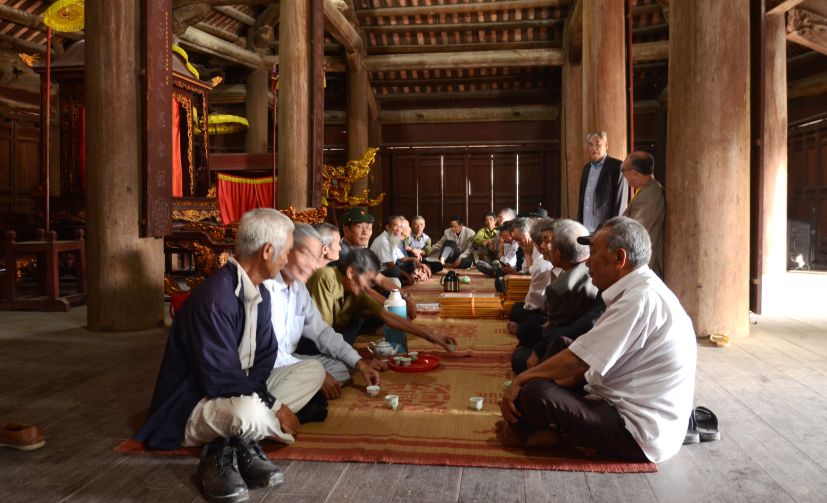
Meeting of the Sections for sacrifice, procession and participants
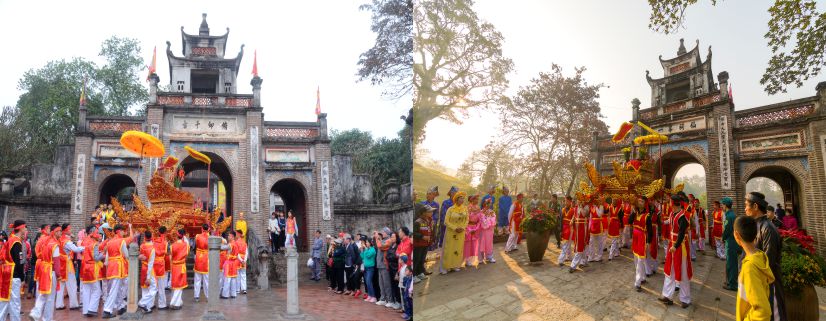
The image of Bát xã’s palanquin procession into Thượng Temple
On the morning of January 6, Bát xã carried a palanquin to Cổ Loa village on both sides. To the west (the right of Thượng Temple), at the Outermost Rampart, the villagers of: Mạch Tràng, Sằn Giã, Đài Bi, and Cầu Cả gather. To the east (the left of Thượng Temple) at Sa market, the villagers of Văn Thượng - Ngoại Sát - Thư Cưu gather.
When the command drum echoes, the two processions enter Thượng temple and join together into one procession at the west end. The procession enters the Rồng Thượng yard in the following order of the palanquin: On the East side: Văn Thượng, Sằn Giã, Đài Bi, Thư Cưu. On the West side: Cổ Loa, Mạch Tràng, Ngoại Sát, Cầu Cả.

The image of Bát xã’s palanquin procession into Thượng Temple

Procession of Anh cả Quậy
According to the legend, Quậy villagers originated from Cổ Loa, who had to move to Hà Vĩ land (Liên Hà commune now) for King Thục to build the citadel. The Bát xã’s villagers considered them as “anh cả Quậy” (Eldest brother Quậy) and invited them to attend the festival and read the imperial edict annually.
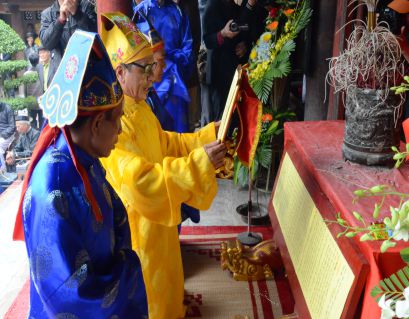
Anh cả Quậy conducts the ceremony for reading the imperial edict
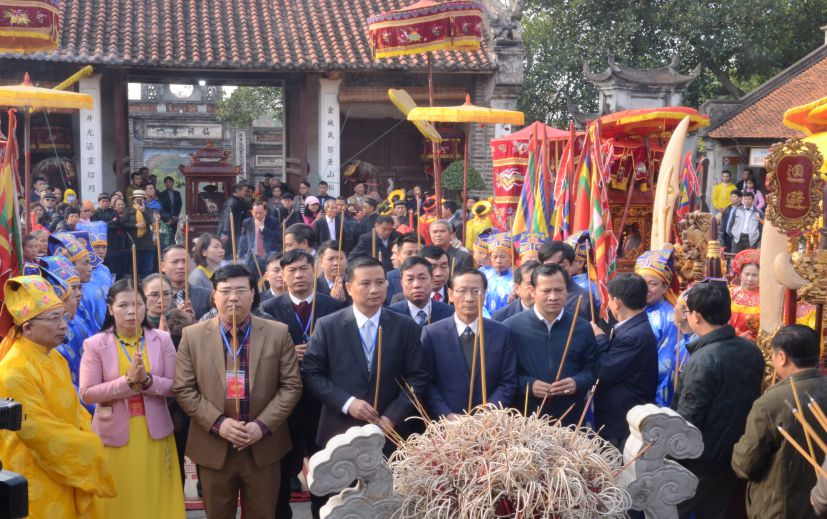
The leaders of Hà Nội city, the Centre for Thăng Long – Hà Nội Heritage Conservation, the People's Committee of Đông Anh district, the local residents and visitors conduct a commemorative thurification
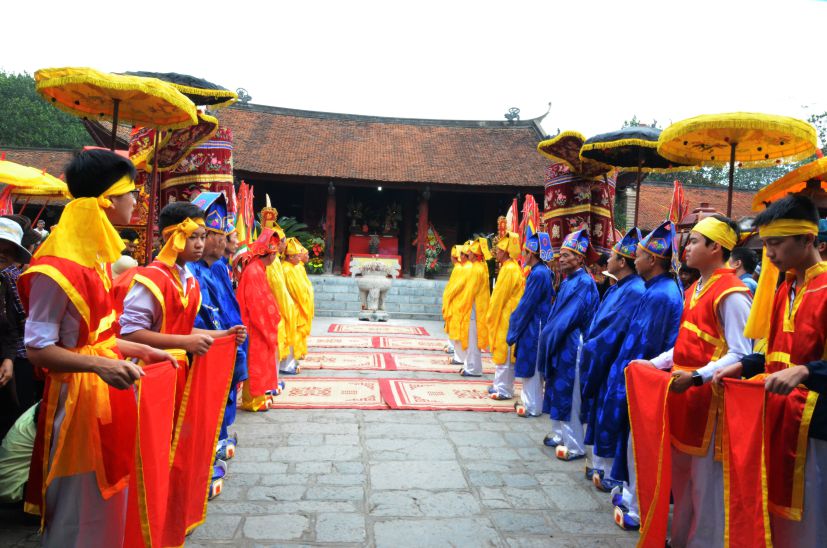
The officials at the ceremony
The Council sacrifice is a solemn and sacred ritual of the royal court in the Cổ Loa festival. In front of the incense, there are four mats in the following order:
First is the divine mat. Second is the main celebrant's mat, where the celebrant enjoys the divine blessings. Third is the main celebrant’s mat. Fourth is the mat for bồi tế (Assistant of the celebrant). The main celebrants are only allowed to set their feet on the mats during the ceremony.
The sacrifice ceremony contains a main celebrant and 25 officials. The celebrant is responsible for the divine sacrifice. The readers stand opposite each other on the east and west sides next to the incense table, who are responsible for reading the rituals. There are 67 reading times in the ceremony.
During the 12 days of the festival, the sacrifice ceremony is conducted at Ngự Triều Di Quy communal house, where the Deities attends the festival: there are two times of sacrifices per day (in the morning and afternoon), and the 24 times of sacrifices in total.

The ceremony of Chấp sự giả các tư kỳ sự (Everyone must pay attention to their jobs)
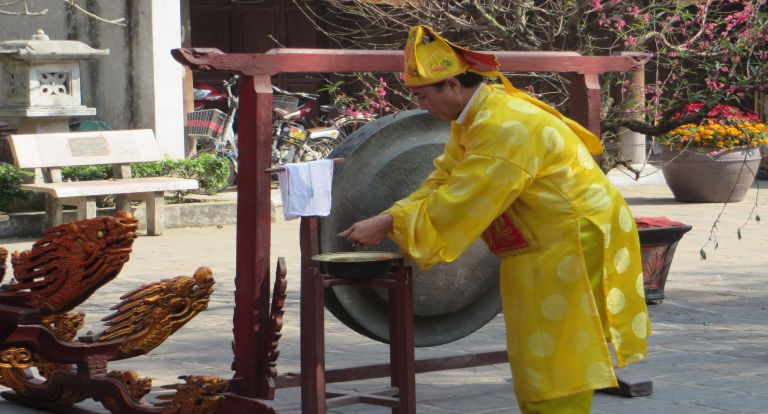
Quán tẩy ceremony (The main celebrant washes his hands)
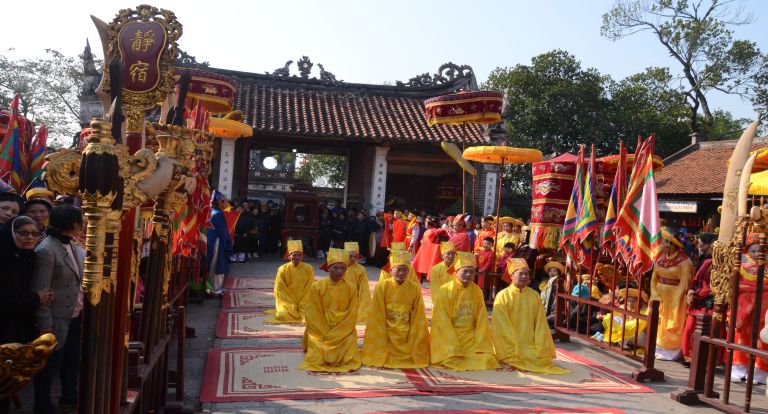
Quỵ ceremony (Everyone Kneel)
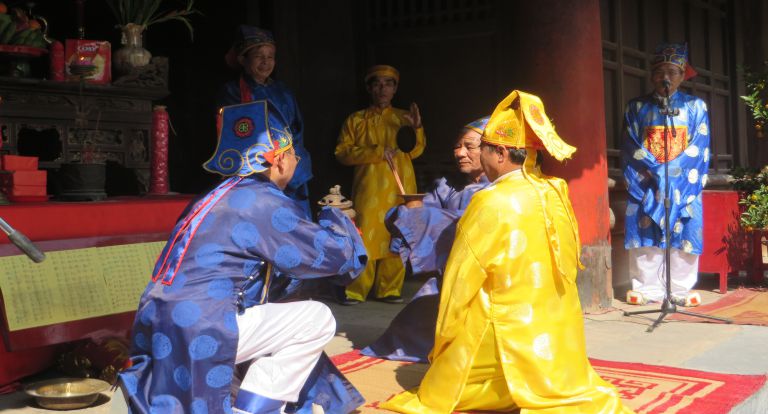
Phủng hương ceremony (One person carry a censer to the celebrant)

Hành sơ hiến lễ ceremony (Offering wine)
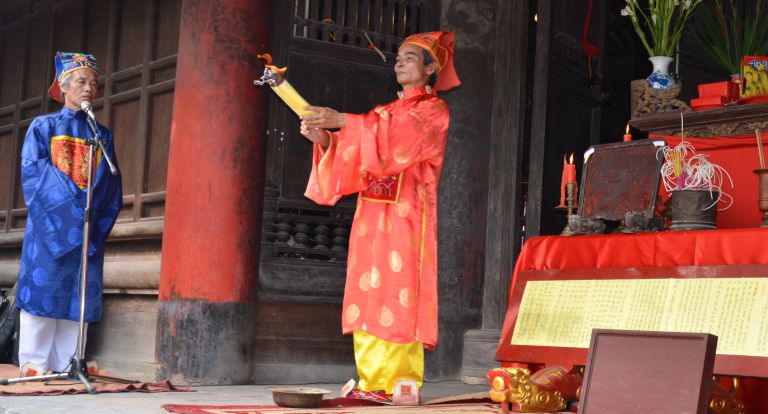
Hóa chúc ceremony (Burning the joss papers)
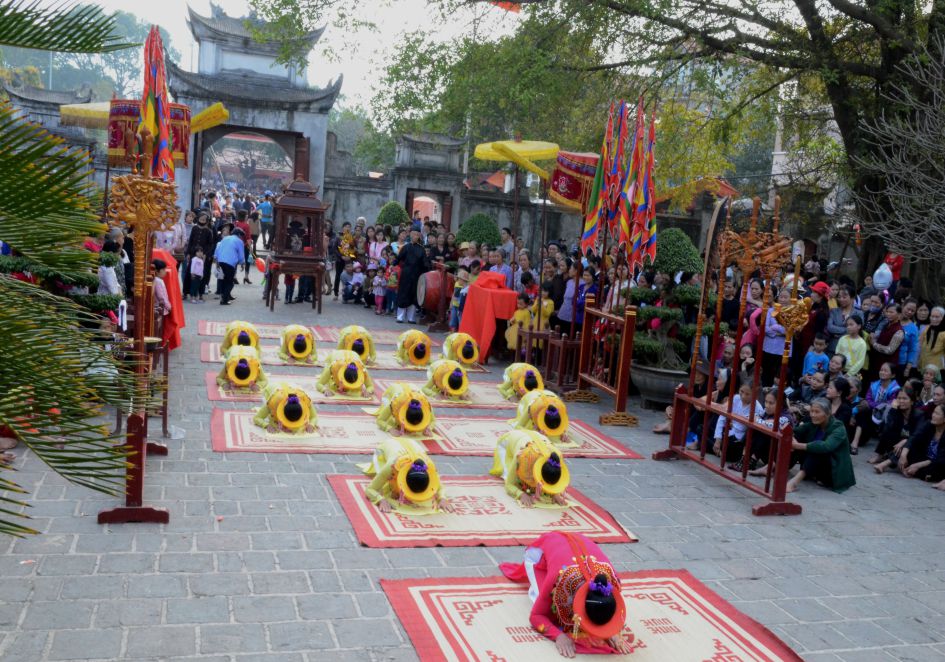
Thập bái ceremony is performed by the female team
Thập bái ceremony is also known as the “Ngũ phúc chúc thọ - Ngũ phúc chúc thành” (5 ceremonies for wishing Happiness - 5 ceremonies for wishing well-done work) or Lễ nghênh and Lễ tất in short. Regulations are kneeling, and praying Buddha
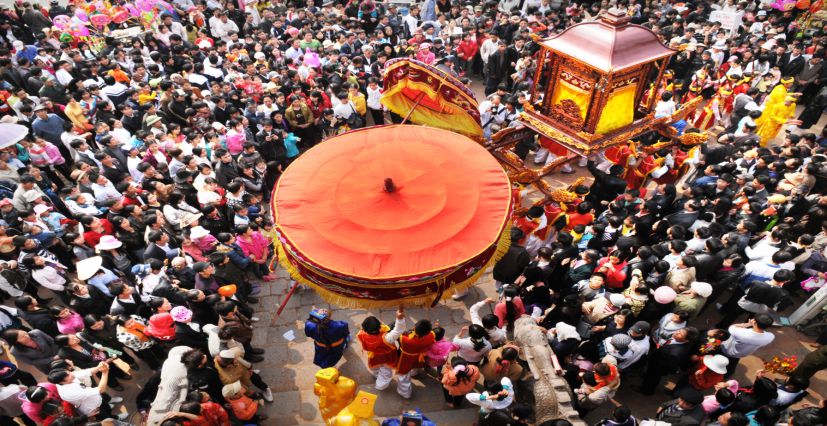
Bát xã’s Procession of palanquin
After the Hội đồng ceremony, there is Bát xã’s procession of palanquin, the palanquin of Cổ Loa village takes the lead, then the palanquins of Văn Thượng, Mạch Tràng, Sằn Giã, Ngoại Sát, Đài Bi, Cầu Cả, Thư Cưu villages respectively. The procession moves from the Rồng Thượng, Rồng Hạ yards, to the temple gate, then around Ngọc-well lake to the crossroads where the procession of Cổ Loa village goes straight to Ngự Triều Di Quy communal house. The other villages’ processions move to their own communal house and continue to hold their festival from the 8th to the 16th of January.
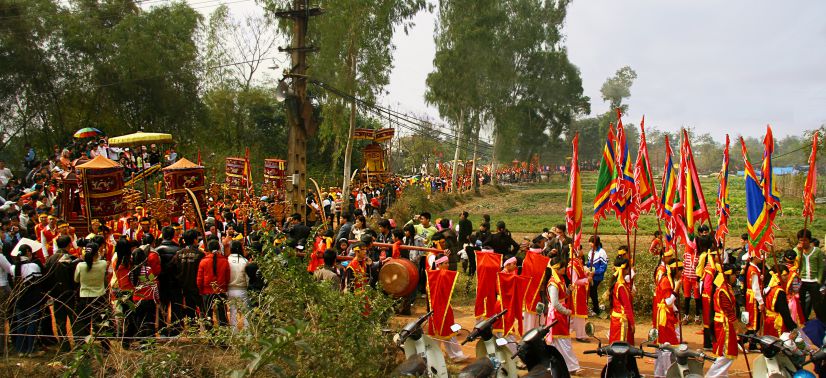
Bát xã’s Procession of palanquin
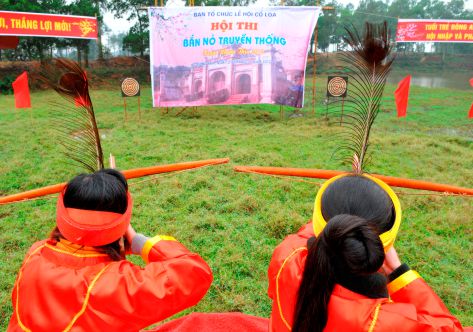
Crossbow shooting
There are many unique folk games in the festival on the front courtyard of the communal house and around the place of worshipping places, where the participants look for most
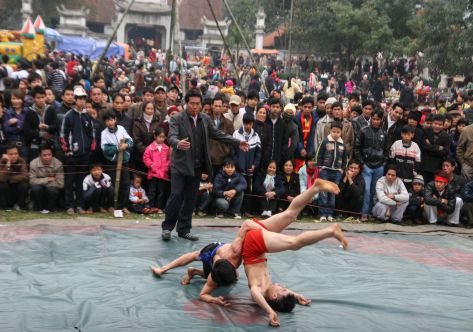
Wrestling
There are many unique folk games in the festival on the front courtyard of the communal house and around the place of worshipping places, where the participants look for most

Human-flag game
There are many unique folk games in the festival on the front courtyard of the communal house and around the place of worshipping places, where the participants look for most
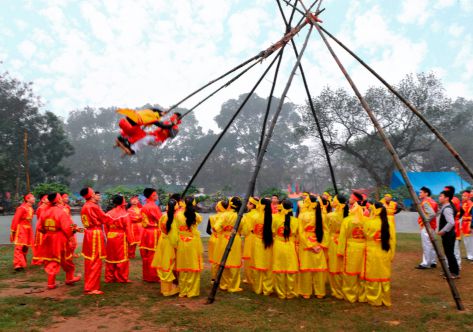
Swinging
There are many unique folk games in the festival on the front courtyard of the communal house and around the place of worshipping places, where the participants look for most

Water Puppet
There are many unique folk games in the festival on the front courtyard of the communal house and around the place of worshipping places, where the participants look for most
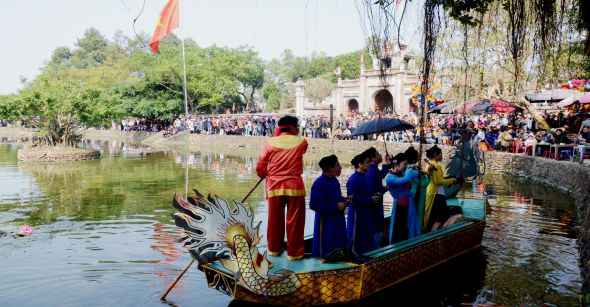
Singing Love Duets
There are many unique folk games in the festival on the front courtyard of the communal house and around the place of worshipping places, where the participants look for most
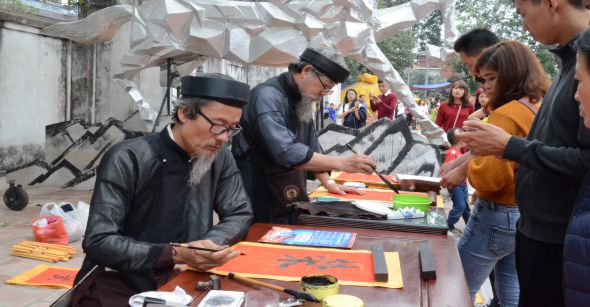
Calligraphy
There are many unique folk games in the festival on the front courtyard of the communal house and around the place of worshipping places, where the participants look for most

Performing Classical dramas, Vietnamese traditional operetta
There are many unique folk games in the festival on the front courtyard of the communal house and around the place of worshipping places, where the participants look for most
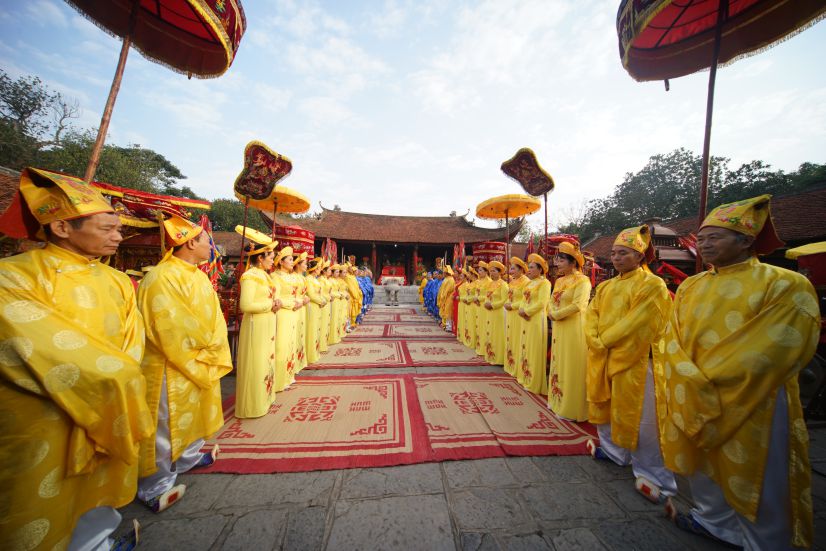
In the old dynasties, costumes were not only aesthetic, but also the symbol of the power of the kings and mandarins. Nowadays, for the traditional festival in general and the Cổ Loa festival in particular, each outfit of the sacrificial officials serves as work of art, with a sophisticated and skillful combination of needle-work and embroidery. Although the costumes are abundant and variform, there is a unity in style, color, and accompanied accessories, etc.
- The celebrant wears a yellow costume, a red mandarin’s boots, and a yellow belt.
- The Eastern reader wears a blue outfit, foot-shaped boots and a belt.
- The Western reader wears a blue outfit, foot-shaped boots and a belt.
- The celebrant’s asistant wears yellow dress, blue foot-shaped boots, and a yellow belt.
- The reader wears red dress, foot-shaped boots and a belt
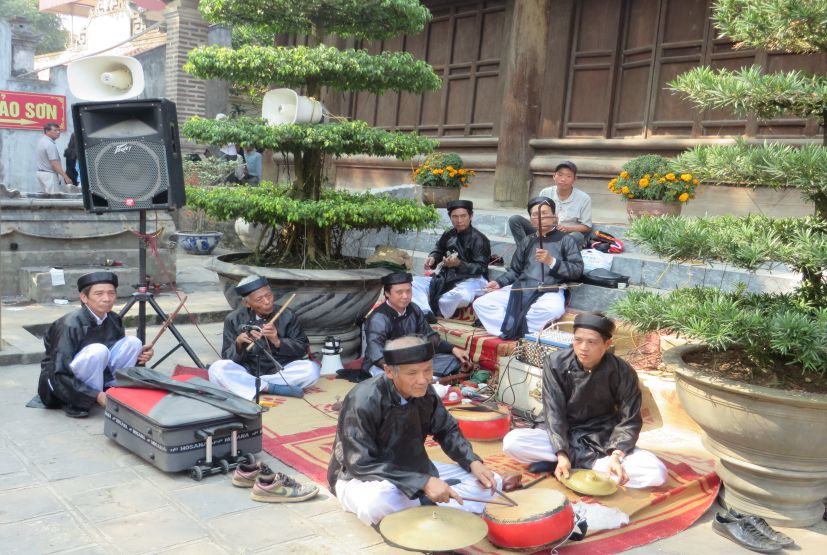
The music role in the festival is very important. The procession of palanquins accompanied by a music group is solemn, bustling and fascinating to everyone. It is an eight-chord music with musical instruments such as drums, gongs, trumpets, two-chord fiddle, lute, and beats. In the sacrifice, the role of the festival music is clear. The female drum, the baby drum, the lah bar, and sinh tiền (wooden musical instrument) are brought into full play after each sacrifice section. The music of sacrifices is not only entertaining, but also assist the celebrant when necessary while he is performing the ceremony according to the unified convention. The classical dramas, Vietnamese traditional operetta require music even more.
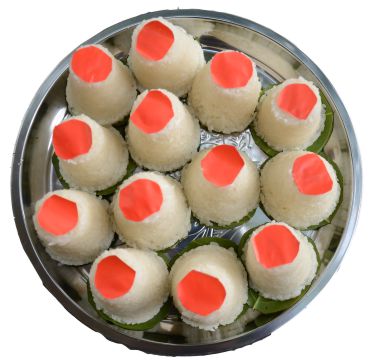
Truncated corns of sticky rice
Previously, the ceremony on January 6 included 1 pig, 2 sets of sticky rice, 1 jar of wine, 1 cluster of areca (30 nuts), fruits, and oranges. From the 6th to the 18th of January, the villages offer daily rituals at temples, communal houses, and small temples, which include vegetarian cakes, sticky-rice cakes, oranges, and fruits. On the evening of January 6, the ceremony for entering the royal palace includes sticky rice, wine, fruit, and oil. On the 9th day, the ceremony for the King’s coronation, there are pork (or one of other three animals), 6 sets of sticky rice, 5 bottles of wine, 100 areca nuts, tea, and fruits.
The Cổ Loa festival nowadays mostly consists of popcorn, sweet sticky rice, chicken, white sticky rice, truncated corns of white sticky rice, various types of fruits mainly including orange, cult flowers like tuberose, roses, and chrysanthemum.
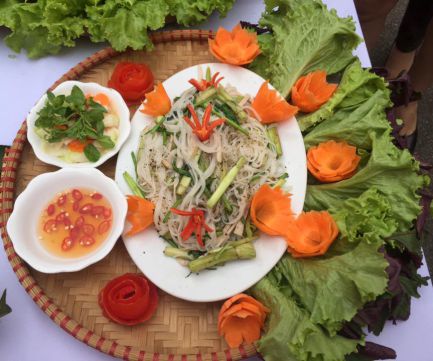
Vermicelli fired water dropwort

Cult items for the festival


